Drivers of Change in Marks & Spencer and House of Fraser
VerifiedAdded on 2023/01/06
|25
|6704
|67
AI Summary
This document discusses the drivers of change in Marks & Spencer and House of Fraser, including technology, customers, competitors, government, and desire for improvement. It also explores the recent changes that have taken place in these organizations and the impact of change on their structure, strategy, and operations.
Contribute Materials
Your contribution can guide someone’s learning journey. Share your
documents today.
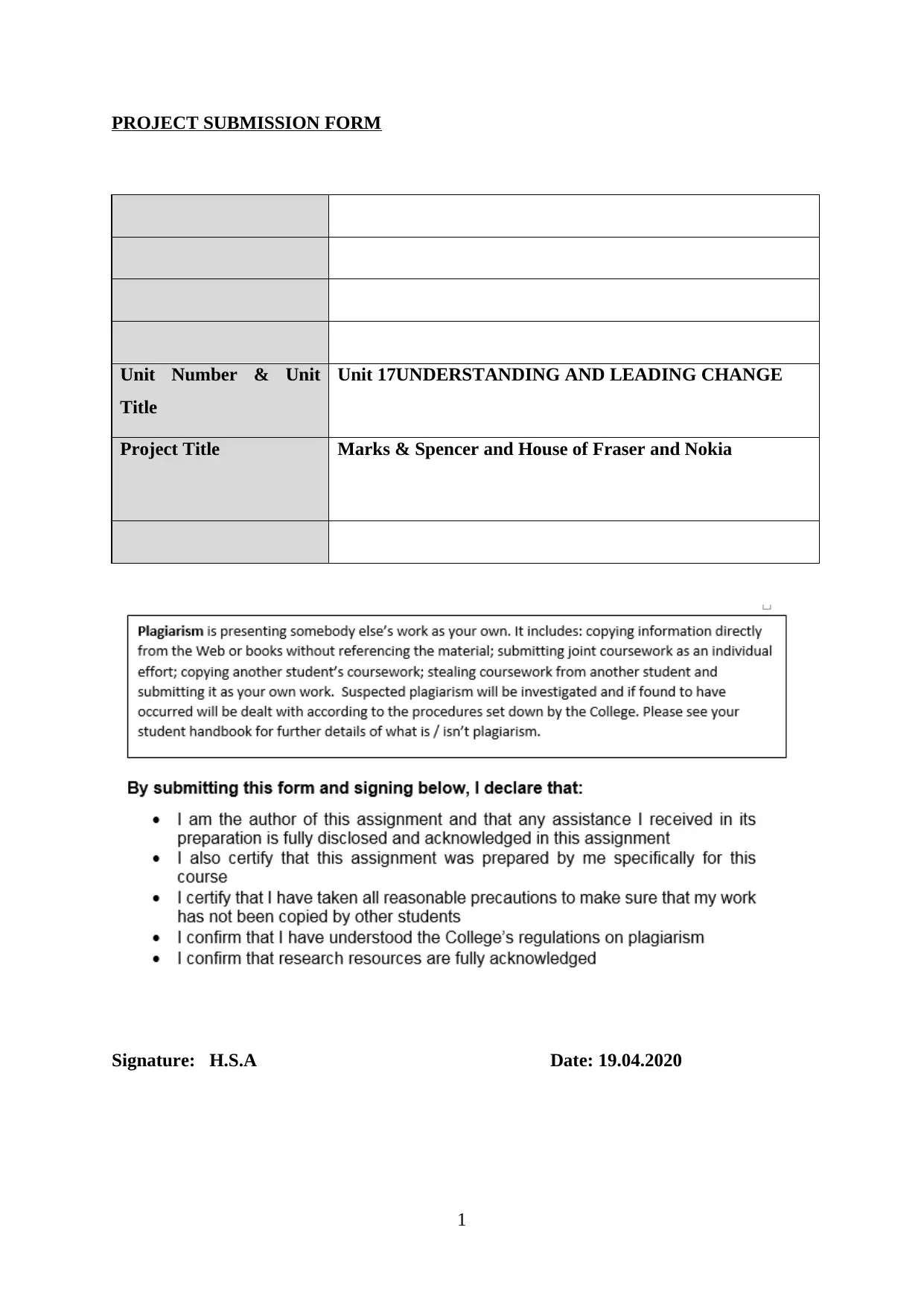
PROJECT SUBMISSION FORM
Unit Number & Unit
Title
Unit 17UNDERSTANDING AND LEADING CHANGE
Project Title Marks & Spencer and House of Fraser and Nokia
Signature: H.S.A Date: 19.04.2020
1
Unit Number & Unit
Title
Unit 17UNDERSTANDING AND LEADING CHANGE
Project Title Marks & Spencer and House of Fraser and Nokia
Signature: H.S.A Date: 19.04.2020
1
Secure Best Marks with AI Grader
Need help grading? Try our AI Grader for instant feedback on your assignments.
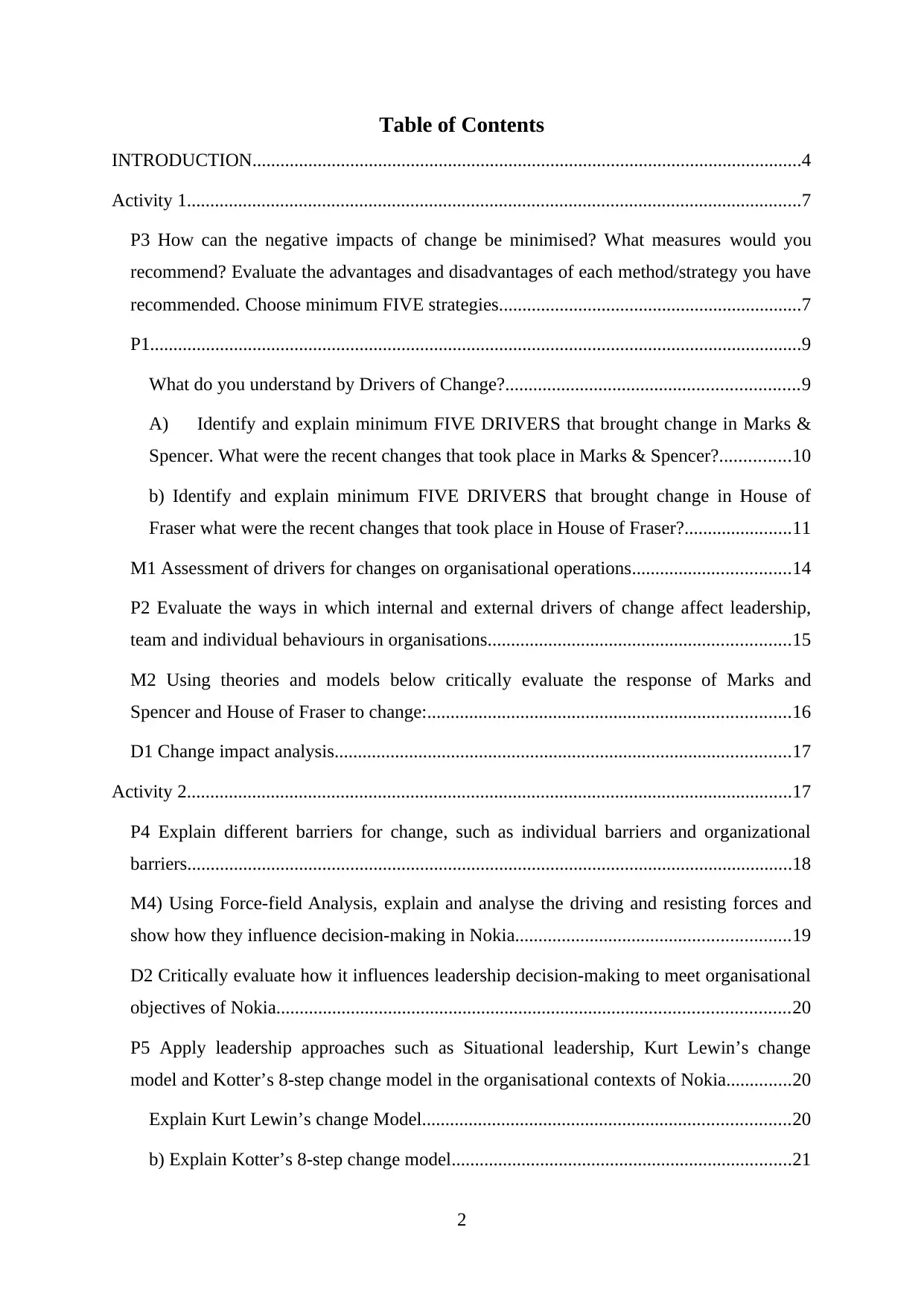
Table of Contents
INTRODUCTION......................................................................................................................4
Activity 1....................................................................................................................................7
P3 How can the negative impacts of change be minimised? What measures would you
recommend? Evaluate the advantages and disadvantages of each method/strategy you have
recommended. Choose minimum FIVE strategies.................................................................7
P1............................................................................................................................................9
What do you understand by Drivers of Change?...............................................................9
A) Identify and explain minimum FIVE DRIVERS that brought change in Marks &
Spencer. What were the recent changes that took place in Marks & Spencer?...............10
b) Identify and explain minimum FIVE DRIVERS that brought change in House of
Fraser what were the recent changes that took place in House of Fraser?.......................11
M1 Assessment of drivers for changes on organisational operations..................................14
P2 Evaluate the ways in which internal and external drivers of change affect leadership,
team and individual behaviours in organisations.................................................................15
M2 Using theories and models below critically evaluate the response of Marks and
Spencer and House of Fraser to change:..............................................................................16
D1 Change impact analysis..................................................................................................17
Activity 2..................................................................................................................................17
P4 Explain different barriers for change, such as individual barriers and organizational
barriers..................................................................................................................................18
M4) Using Force-field Analysis, explain and analyse the driving and resisting forces and
show how they influence decision-making in Nokia...........................................................19
D2 Critically evaluate how it influences leadership decision-making to meet organisational
objectives of Nokia..............................................................................................................20
P5 Apply leadership approaches such as Situational leadership, Kurt Lewin’s change
model and Kotter’s 8-step change model in the organisational contexts of Nokia..............20
Explain Kurt Lewin’s change Model...............................................................................20
b) Explain Kotter’s 8-step change model.........................................................................21
2
INTRODUCTION......................................................................................................................4
Activity 1....................................................................................................................................7
P3 How can the negative impacts of change be minimised? What measures would you
recommend? Evaluate the advantages and disadvantages of each method/strategy you have
recommended. Choose minimum FIVE strategies.................................................................7
P1............................................................................................................................................9
What do you understand by Drivers of Change?...............................................................9
A) Identify and explain minimum FIVE DRIVERS that brought change in Marks &
Spencer. What were the recent changes that took place in Marks & Spencer?...............10
b) Identify and explain minimum FIVE DRIVERS that brought change in House of
Fraser what were the recent changes that took place in House of Fraser?.......................11
M1 Assessment of drivers for changes on organisational operations..................................14
P2 Evaluate the ways in which internal and external drivers of change affect leadership,
team and individual behaviours in organisations.................................................................15
M2 Using theories and models below critically evaluate the response of Marks and
Spencer and House of Fraser to change:..............................................................................16
D1 Change impact analysis..................................................................................................17
Activity 2..................................................................................................................................17
P4 Explain different barriers for change, such as individual barriers and organizational
barriers..................................................................................................................................18
M4) Using Force-field Analysis, explain and analyse the driving and resisting forces and
show how they influence decision-making in Nokia...........................................................19
D2 Critically evaluate how it influences leadership decision-making to meet organisational
objectives of Nokia..............................................................................................................20
P5 Apply leadership approaches such as Situational leadership, Kurt Lewin’s change
model and Kotter’s 8-step change model in the organisational contexts of Nokia..............20
Explain Kurt Lewin’s change Model...............................................................................20
b) Explain Kotter’s 8-step change model.........................................................................21
2

b) Explain Situational Leadership..............................................................................22
Critically evaluate the effectiveness of the above leadership approaches and models of
change management in delivering organisational change....................................................23
REFERENCES.........................................................................................................................24
Negative Impact of Organizational Change on Employees.....................................................25
3
Critically evaluate the effectiveness of the above leadership approaches and models of
change management in delivering organisational change....................................................23
REFERENCES.........................................................................................................................24
Negative Impact of Organizational Change on Employees.....................................................25
3
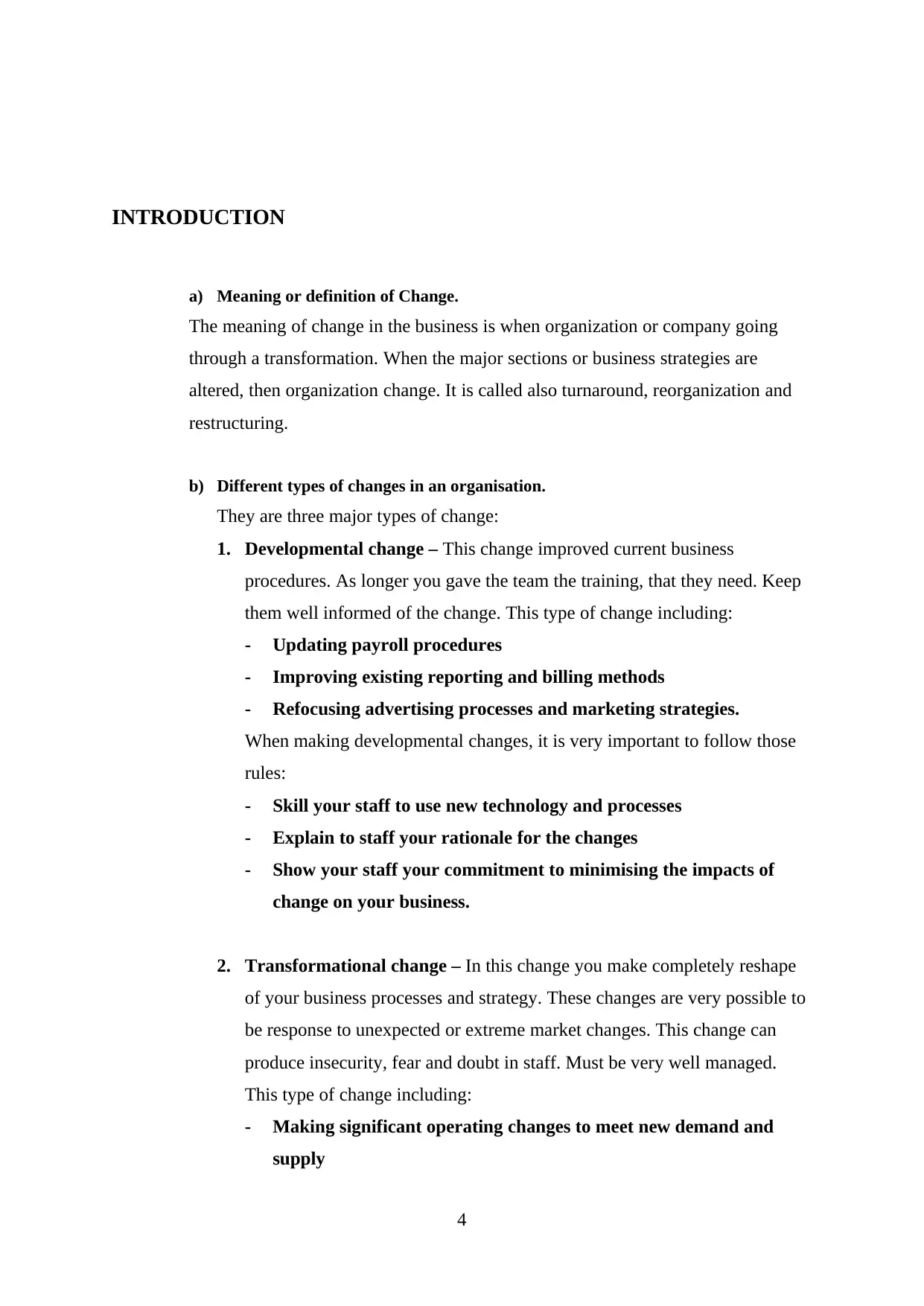
INTRODUCTION
a) Meaning or definition of Change.
The meaning of change in the business is when organization or company going
through a transformation. When the major sections or business strategies are
altered, then organization change. It is called also turnaround, reorganization and
restructuring.
b) Different types of changes in an organisation.
They are three major types of change:
1. Developmental change – This change improved current business
procedures. As longer you gave the team the training, that they need. Keep
them well informed of the change. This type of change including:
- Updating payroll procedures
- Improving existing reporting and billing methods
- Refocusing advertising processes and marketing strategies.
When making developmental changes, it is very important to follow those
rules:
- Skill your staff to use new technology and processes
- Explain to staff your rationale for the changes
- Show your staff your commitment to minimising the impacts of
change on your business.
2. Transformational change – In this change you make completely reshape
of your business processes and strategy. These changes are very possible to
be response to unexpected or extreme market changes. This change can
produce insecurity, fear and doubt in staff. Must be very well managed.
This type of change including:
- Making significant operating changes to meet new demand and
supply
4
a) Meaning or definition of Change.
The meaning of change in the business is when organization or company going
through a transformation. When the major sections or business strategies are
altered, then organization change. It is called also turnaround, reorganization and
restructuring.
b) Different types of changes in an organisation.
They are three major types of change:
1. Developmental change – This change improved current business
procedures. As longer you gave the team the training, that they need. Keep
them well informed of the change. This type of change including:
- Updating payroll procedures
- Improving existing reporting and billing methods
- Refocusing advertising processes and marketing strategies.
When making developmental changes, it is very important to follow those
rules:
- Skill your staff to use new technology and processes
- Explain to staff your rationale for the changes
- Show your staff your commitment to minimising the impacts of
change on your business.
2. Transformational change – In this change you make completely reshape
of your business processes and strategy. These changes are very possible to
be response to unexpected or extreme market changes. This change can
produce insecurity, fear and doubt in staff. Must be very well managed.
This type of change including:
- Making significant operating changes to meet new demand and
supply
4
Secure Best Marks with AI Grader
Need help grading? Try our AI Grader for instant feedback on your assignments.
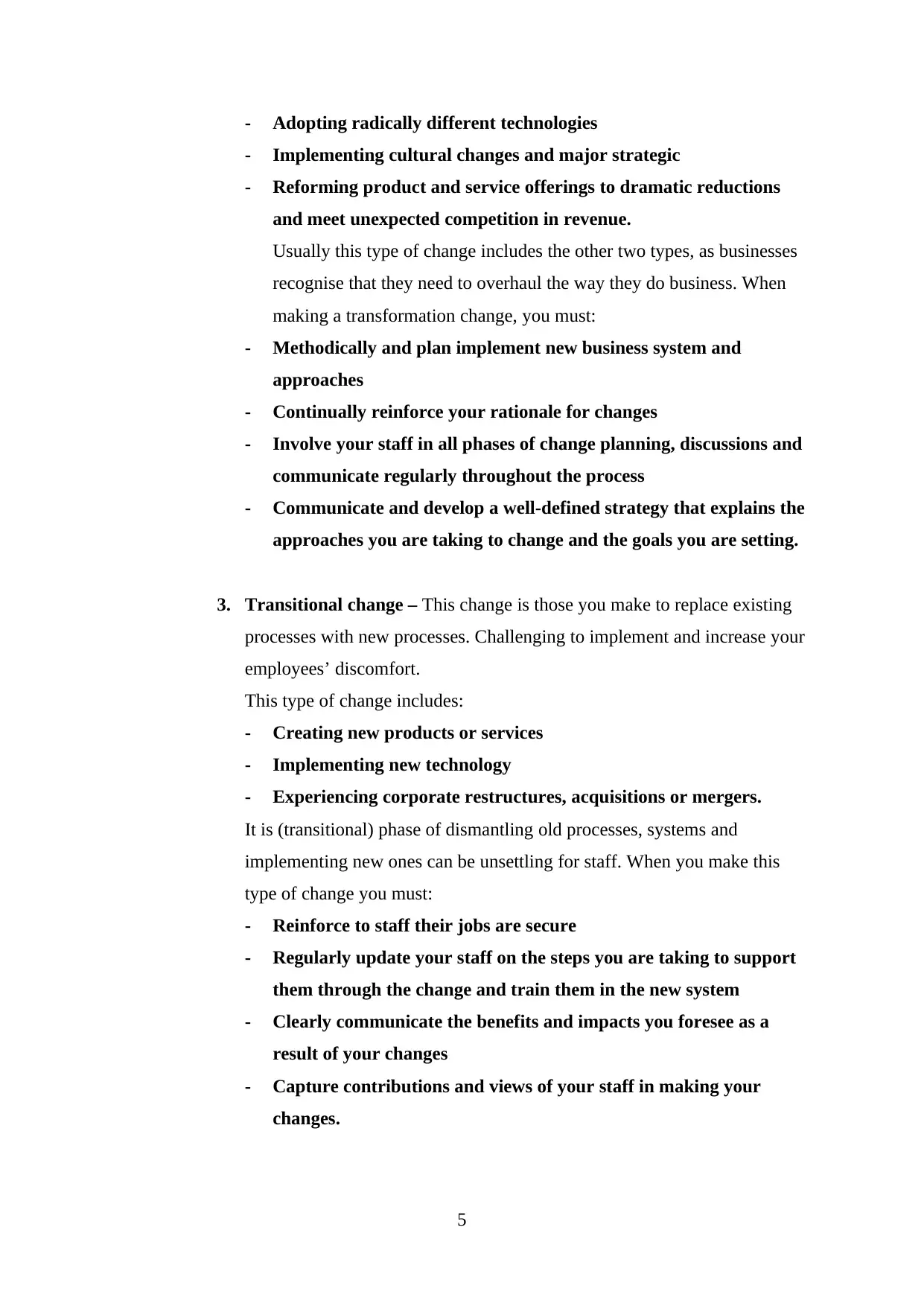
- Adopting radically different technologies
- Implementing cultural changes and major strategic
- Reforming product and service offerings to dramatic reductions
and meet unexpected competition in revenue.
Usually this type of change includes the other two types, as businesses
recognise that they need to overhaul the way they do business. When
making a transformation change, you must:
- Methodically and plan implement new business system and
approaches
- Continually reinforce your rationale for changes
- Involve your staff in all phases of change planning, discussions and
communicate regularly throughout the process
- Communicate and develop a well-defined strategy that explains the
approaches you are taking to change and the goals you are setting.
3. Transitional change – This change is those you make to replace existing
processes with new processes. Challenging to implement and increase your
employees’ discomfort.
This type of change includes:
- Creating new products or services
- Implementing new technology
- Experiencing corporate restructures, acquisitions or mergers.
It is (transitional) phase of dismantling old processes, systems and
implementing new ones can be unsettling for staff. When you make this
type of change you must:
- Reinforce to staff their jobs are secure
- Regularly update your staff on the steps you are taking to support
them through the change and train them in the new system
- Clearly communicate the benefits and impacts you foresee as a
result of your changes
- Capture contributions and views of your staff in making your
changes.
5
- Implementing cultural changes and major strategic
- Reforming product and service offerings to dramatic reductions
and meet unexpected competition in revenue.
Usually this type of change includes the other two types, as businesses
recognise that they need to overhaul the way they do business. When
making a transformation change, you must:
- Methodically and plan implement new business system and
approaches
- Continually reinforce your rationale for changes
- Involve your staff in all phases of change planning, discussions and
communicate regularly throughout the process
- Communicate and develop a well-defined strategy that explains the
approaches you are taking to change and the goals you are setting.
3. Transitional change – This change is those you make to replace existing
processes with new processes. Challenging to implement and increase your
employees’ discomfort.
This type of change includes:
- Creating new products or services
- Implementing new technology
- Experiencing corporate restructures, acquisitions or mergers.
It is (transitional) phase of dismantling old processes, systems and
implementing new ones can be unsettling for staff. When you make this
type of change you must:
- Reinforce to staff their jobs are secure
- Regularly update your staff on the steps you are taking to support
them through the change and train them in the new system
- Clearly communicate the benefits and impacts you foresee as a
result of your changes
- Capture contributions and views of your staff in making your
changes.
5

c) Explain briefly how change can be perceived as positive?
Change can be perceived as positive in a few ways, for example there can be
new business opportunities, increased business efficiency, improved employee
morale and attitudes, encouraging business innovation or staying current with the
industry trends. The ability to embrace change can be very helpful to employees in
a business by creating new opportunities. Change can help a business to stay
current with industry trends. Change can make it more attractive to potential
customers as well as help maintain current customers. Businesses that are adept at
handling or ever embracing change can foster an environment that encourages
innovation. However, one marketing idea or good product can make a big
difference in the success of a small business. It can be positive also in increasing
the efficiency of work processes, which is very big possibility to make more
satisfied customers as well as employees. Switching to a computerized payroll
process may mean that a salesperson is paid his commissions sooner. The
personnel or philosophical change in an organization can have a positive effect on
employee morale and attitudes. A change in philosophy of human resources allows
more relaxed work environment, such as implementing a casual dress code, may be
welcomed by employees. For example, when close – minded manager is replaced
with new one who is open to new ideas, employees may feel that they have more
pressure regarding their job functions.
d) Explain briefly how change can be perceived as negative?
Change can be perceived as a negative in a few ways as well. For example: loss
of loyalty and increased turnover, life changes caused by restructuring, increased
time away from work or impact of mental stress. In two thousand and seventeen
APA (American Psychological Association) concluded that over fifty percent of
the people who was experienced organizational change at work reported feeling
chronic stress, compared with twenty two percent people who did not have
organizational upheaval. Over thirty percent said they felt physical symptoms from
their stress at work, compared with less than ten percent having such symptoms
6
Change can be perceived as positive in a few ways, for example there can be
new business opportunities, increased business efficiency, improved employee
morale and attitudes, encouraging business innovation or staying current with the
industry trends. The ability to embrace change can be very helpful to employees in
a business by creating new opportunities. Change can help a business to stay
current with industry trends. Change can make it more attractive to potential
customers as well as help maintain current customers. Businesses that are adept at
handling or ever embracing change can foster an environment that encourages
innovation. However, one marketing idea or good product can make a big
difference in the success of a small business. It can be positive also in increasing
the efficiency of work processes, which is very big possibility to make more
satisfied customers as well as employees. Switching to a computerized payroll
process may mean that a salesperson is paid his commissions sooner. The
personnel or philosophical change in an organization can have a positive effect on
employee morale and attitudes. A change in philosophy of human resources allows
more relaxed work environment, such as implementing a casual dress code, may be
welcomed by employees. For example, when close – minded manager is replaced
with new one who is open to new ideas, employees may feel that they have more
pressure regarding their job functions.
d) Explain briefly how change can be perceived as negative?
Change can be perceived as a negative in a few ways as well. For example: loss
of loyalty and increased turnover, life changes caused by restructuring, increased
time away from work or impact of mental stress. In two thousand and seventeen
APA (American Psychological Association) concluded that over fifty percent of
the people who was experienced organizational change at work reported feeling
chronic stress, compared with twenty two percent people who did not have
organizational upheaval. Over thirty percent said they felt physical symptoms from
their stress at work, compared with less than ten percent having such symptoms
6
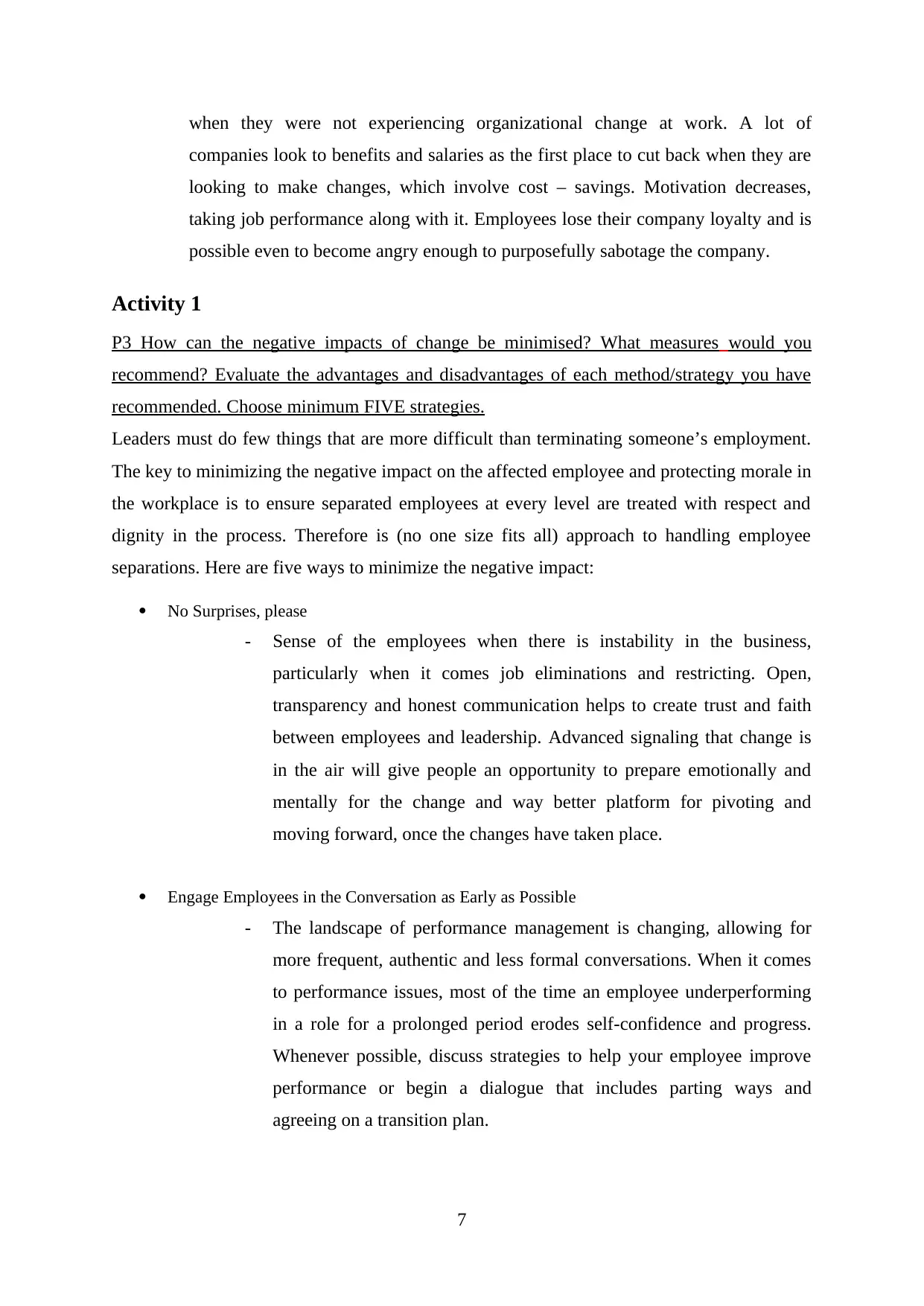
when they were not experiencing organizational change at work. A lot of
companies look to benefits and salaries as the first place to cut back when they are
looking to make changes, which involve cost – savings. Motivation decreases,
taking job performance along with it. Employees lose their company loyalty and is
possible even to become angry enough to purposefully sabotage the company.
Activity 1
P3 How can the negative impacts of change be minimised? What measures would you
recommend? Evaluate the advantages and disadvantages of each method/strategy you have
recommended. Choose minimum FIVE strategies.
Leaders must do few things that are more difficult than terminating someone’s employment.
The key to minimizing the negative impact on the affected employee and protecting morale in
the workplace is to ensure separated employees at every level are treated with respect and
dignity in the process. Therefore is (no one size fits all) approach to handling employee
separations. Here are five ways to minimize the negative impact:
No Surprises, please
- Sense of the employees when there is instability in the business,
particularly when it comes job eliminations and restricting. Open,
transparency and honest communication helps to create trust and faith
between employees and leadership. Advanced signaling that change is
in the air will give people an opportunity to prepare emotionally and
mentally for the change and way better platform for pivoting and
moving forward, once the changes have taken place.
Engage Employees in the Conversation as Early as Possible
- The landscape of performance management is changing, allowing for
more frequent, authentic and less formal conversations. When it comes
to performance issues, most of the time an employee underperforming
in a role for a prolonged period erodes self-confidence and progress.
Whenever possible, discuss strategies to help your employee improve
performance or begin a dialogue that includes parting ways and
agreeing on a transition plan.
7
companies look to benefits and salaries as the first place to cut back when they are
looking to make changes, which involve cost – savings. Motivation decreases,
taking job performance along with it. Employees lose their company loyalty and is
possible even to become angry enough to purposefully sabotage the company.
Activity 1
P3 How can the negative impacts of change be minimised? What measures would you
recommend? Evaluate the advantages and disadvantages of each method/strategy you have
recommended. Choose minimum FIVE strategies.
Leaders must do few things that are more difficult than terminating someone’s employment.
The key to minimizing the negative impact on the affected employee and protecting morale in
the workplace is to ensure separated employees at every level are treated with respect and
dignity in the process. Therefore is (no one size fits all) approach to handling employee
separations. Here are five ways to minimize the negative impact:
No Surprises, please
- Sense of the employees when there is instability in the business,
particularly when it comes job eliminations and restricting. Open,
transparency and honest communication helps to create trust and faith
between employees and leadership. Advanced signaling that change is
in the air will give people an opportunity to prepare emotionally and
mentally for the change and way better platform for pivoting and
moving forward, once the changes have taken place.
Engage Employees in the Conversation as Early as Possible
- The landscape of performance management is changing, allowing for
more frequent, authentic and less formal conversations. When it comes
to performance issues, most of the time an employee underperforming
in a role for a prolonged period erodes self-confidence and progress.
Whenever possible, discuss strategies to help your employee improve
performance or begin a dialogue that includes parting ways and
agreeing on a transition plan.
7
Paraphrase This Document
Need a fresh take? Get an instant paraphrase of this document with our AI Paraphraser
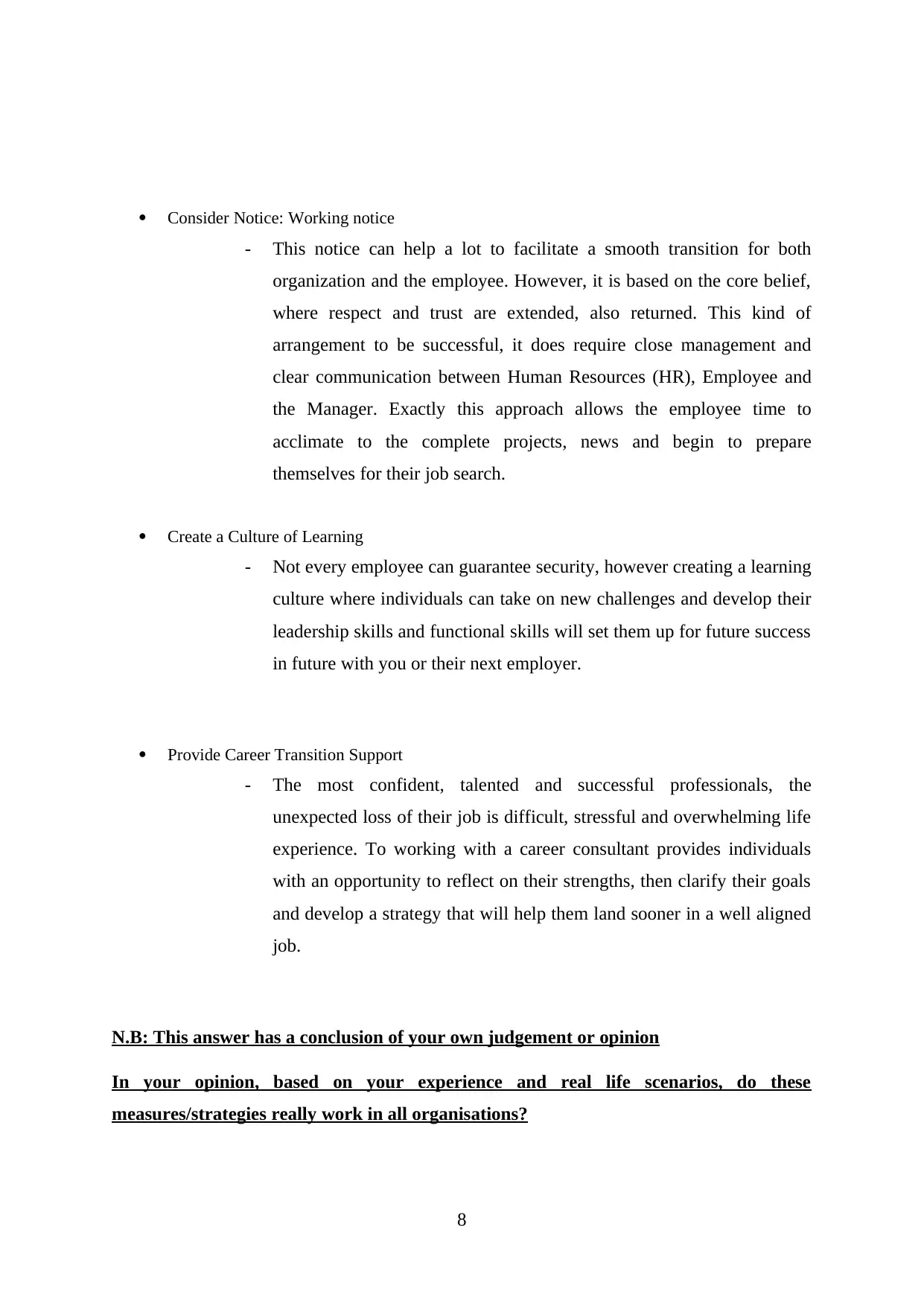
Consider Notice: Working notice
- This notice can help a lot to facilitate a smooth transition for both
organization and the employee. However, it is based on the core belief,
where respect and trust are extended, also returned. This kind of
arrangement to be successful, it does require close management and
clear communication between Human Resources (HR), Employee and
the Manager. Exactly this approach allows the employee time to
acclimate to the complete projects, news and begin to prepare
themselves for their job search.
Create a Culture of Learning
- Not every employee can guarantee security, however creating a learning
culture where individuals can take on new challenges and develop their
leadership skills and functional skills will set them up for future success
in future with you or their next employer.
Provide Career Transition Support
- The most confident, talented and successful professionals, the
unexpected loss of their job is difficult, stressful and overwhelming life
experience. To working with a career consultant provides individuals
with an opportunity to reflect on their strengths, then clarify their goals
and develop a strategy that will help them land sooner in a well aligned
job.
N.B: This answer has a conclusion of your own judgement or opinion
In your opinion, based on your experience and real life scenarios, do these
measures/strategies really work in all organisations?
8
- This notice can help a lot to facilitate a smooth transition for both
organization and the employee. However, it is based on the core belief,
where respect and trust are extended, also returned. This kind of
arrangement to be successful, it does require close management and
clear communication between Human Resources (HR), Employee and
the Manager. Exactly this approach allows the employee time to
acclimate to the complete projects, news and begin to prepare
themselves for their job search.
Create a Culture of Learning
- Not every employee can guarantee security, however creating a learning
culture where individuals can take on new challenges and develop their
leadership skills and functional skills will set them up for future success
in future with you or their next employer.
Provide Career Transition Support
- The most confident, talented and successful professionals, the
unexpected loss of their job is difficult, stressful and overwhelming life
experience. To working with a career consultant provides individuals
with an opportunity to reflect on their strengths, then clarify their goals
and develop a strategy that will help them land sooner in a well aligned
job.
N.B: This answer has a conclusion of your own judgement or opinion
In your opinion, based on your experience and real life scenarios, do these
measures/strategies really work in all organisations?
8
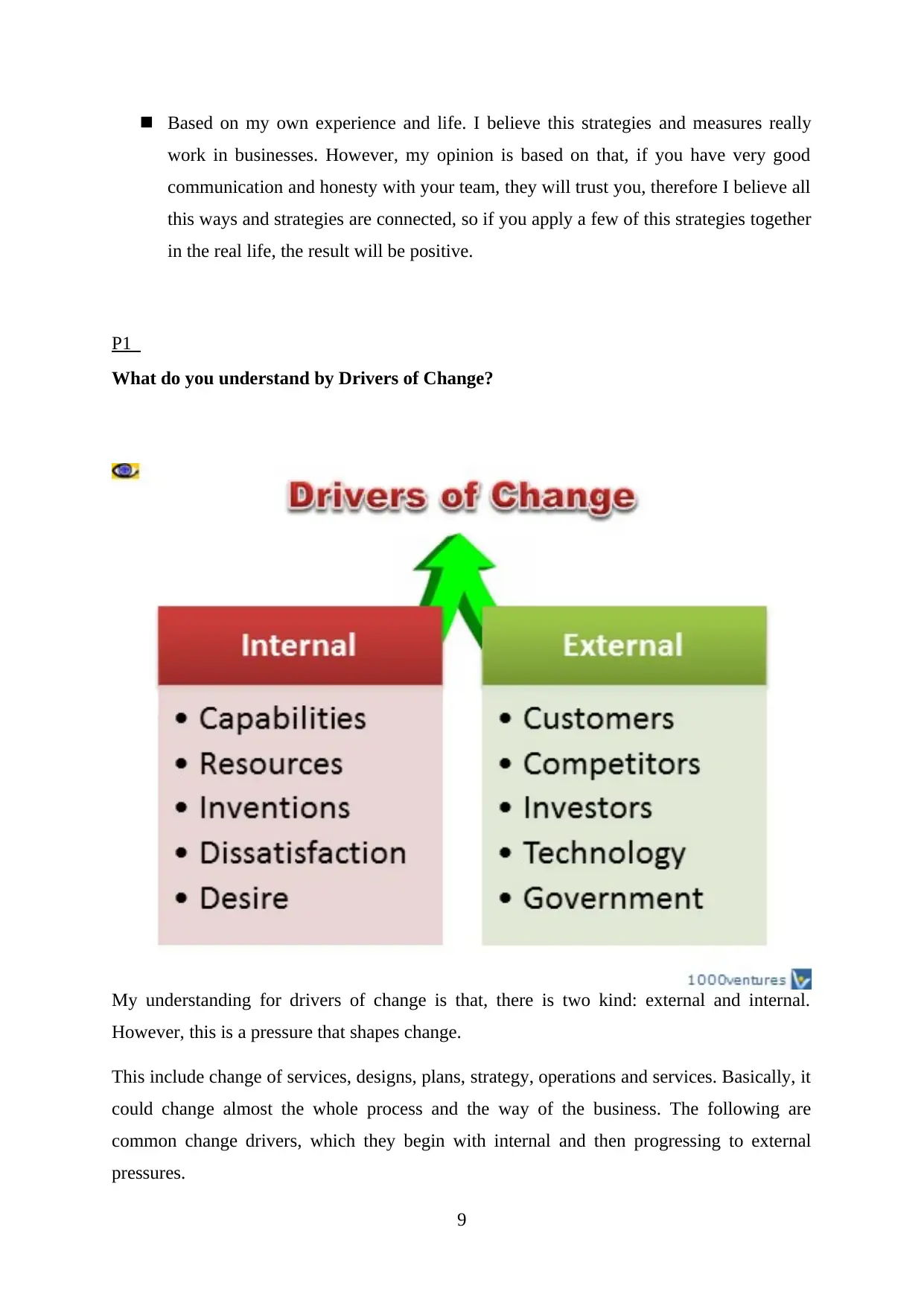
Based on my own experience and life. I believe this strategies and measures really
work in businesses. However, my opinion is based on that, if you have very good
communication and honesty with your team, they will trust you, therefore I believe all
this ways and strategies are connected, so if you apply a few of this strategies together
in the real life, the result will be positive.
P1
What do you understand by Drivers of Change?
My understanding for drivers of change is that, there is two kind: external and internal.
However, this is a pressure that shapes change.
This include change of services, designs, plans, strategy, operations and services. Basically, it
could change almost the whole process and the way of the business. The following are
common change drivers, which they begin with internal and then progressing to external
pressures.
9
work in businesses. However, my opinion is based on that, if you have very good
communication and honesty with your team, they will trust you, therefore I believe all
this ways and strategies are connected, so if you apply a few of this strategies together
in the real life, the result will be positive.
P1
What do you understand by Drivers of Change?
My understanding for drivers of change is that, there is two kind: external and internal.
However, this is a pressure that shapes change.
This include change of services, designs, plans, strategy, operations and services. Basically, it
could change almost the whole process and the way of the business. The following are
common change drivers, which they begin with internal and then progressing to external
pressures.
9

A) Identify and explain minimum FIVE DRIVERS that brought change in Marks &
Spencer. What were the recent changes that took place in Marks & Spencer?
(Identify both External and internal drivers which is applicable)
Eg: Technology can be external and internal driver. What changes did this driver bring in
Marks and Spencer?
Technology
Technology is one of the important drivers of change that brought change in
Marks and Spencer. M&S announced a new technology transformation program that
will enable it to become a digital-first business and deliver improved customer
experience. Technology transfer is aimed at creating more agile, faster and
commercial technology. This is recent changes that have been announced by M&S.
Customers
This is another important driver of change in which M&S bring changes
within organization based on changing requirements of the customers. This change
ensures that M&S is capable to deal with changing customer requirements and this is
also important for retaining customers.
Competitors
This is another driver in which M&S and changes in its organization are
encouraged by competitors and their activities. M&S is operating in an intense
competitive environment and in order to get competitive advantage certain changes
are important to implement.
Government
This is another important driver of change, government play important role in
operating organization. Government brings changes in policies and this requires that
M&S also implement changes in its operations. For example – government brings
changes in policies of environment safety and sustainability, M&S will have to
changes in its activities in order to comply with government policies.
Desire
This is another important driver in this when M&S realize that its practices
and operations require changes in order to improve them. In order to enhance existing
practices organization can bring changes.
10
Spencer. What were the recent changes that took place in Marks & Spencer?
(Identify both External and internal drivers which is applicable)
Eg: Technology can be external and internal driver. What changes did this driver bring in
Marks and Spencer?
Technology
Technology is one of the important drivers of change that brought change in
Marks and Spencer. M&S announced a new technology transformation program that
will enable it to become a digital-first business and deliver improved customer
experience. Technology transfer is aimed at creating more agile, faster and
commercial technology. This is recent changes that have been announced by M&S.
Customers
This is another important driver of change in which M&S bring changes
within organization based on changing requirements of the customers. This change
ensures that M&S is capable to deal with changing customer requirements and this is
also important for retaining customers.
Competitors
This is another driver in which M&S and changes in its organization are
encouraged by competitors and their activities. M&S is operating in an intense
competitive environment and in order to get competitive advantage certain changes
are important to implement.
Government
This is another important driver of change, government play important role in
operating organization. Government brings changes in policies and this requires that
M&S also implement changes in its operations. For example – government brings
changes in policies of environment safety and sustainability, M&S will have to
changes in its activities in order to comply with government policies.
Desire
This is another important driver in this when M&S realize that its practices
and operations require changes in order to improve them. In order to enhance existing
practices organization can bring changes.
10
Secure Best Marks with AI Grader
Need help grading? Try our AI Grader for instant feedback on your assignments.

b) Identify and explain minimum FIVE DRIVERS that brought change in House of
Fraser what were the recent changes that took place in House of Fraser?
(Identify both External and internal drivers whichever is applicable)
a) Compare Marks and Spencer and House of Frazer where there has been an impact of change
on their structure, strategy and operations
MARKS AND SPENCER HOUSE OF FRAZER
ORGANISATIONA
L STRUCTURE
Due to the impact of changes,
marks and spencer have
transformed within the
organisation by ways of
changing the way things are
done - with its corporate
culture been more dynamic
and flexible.
For that reason, there have
been changes to top
management byways of
restructuring the overall level
management. As such, Steve
Rowe takes over where all
undertakings are directed.
HOF are investing millions in
transforming 7 House of Fraser
into luxury stores. The name will
be shortened to Fraser.
House of Fraser have advised
suppliers that they will be divide
into two divisions with HOF
catering for the mass market and
Fraser stocking more designer
labels. The first store to get a
maker over will be HOF flagship
store in Belfast as well as being
rebranded.
House of Fraser are planning to
revamp their department store to
make it a place where customer
would want to shop again,
providing customer with the
discounted brands whilst still
providing a premium service. This
will help to transform the business
to make it more profitable.
BBC has advised that the HOF will
be closing 4 major stores because
11
Fraser what were the recent changes that took place in House of Fraser?
(Identify both External and internal drivers whichever is applicable)
a) Compare Marks and Spencer and House of Frazer where there has been an impact of change
on their structure, strategy and operations
MARKS AND SPENCER HOUSE OF FRAZER
ORGANISATIONA
L STRUCTURE
Due to the impact of changes,
marks and spencer have
transformed within the
organisation by ways of
changing the way things are
done - with its corporate
culture been more dynamic
and flexible.
For that reason, there have
been changes to top
management byways of
restructuring the overall level
management. As such, Steve
Rowe takes over where all
undertakings are directed.
HOF are investing millions in
transforming 7 House of Fraser
into luxury stores. The name will
be shortened to Fraser.
House of Fraser have advised
suppliers that they will be divide
into two divisions with HOF
catering for the mass market and
Fraser stocking more designer
labels. The first store to get a
maker over will be HOF flagship
store in Belfast as well as being
rebranded.
House of Fraser are planning to
revamp their department store to
make it a place where customer
would want to shop again,
providing customer with the
discounted brands whilst still
providing a premium service. This
will help to transform the business
to make it more profitable.
BBC has advised that the HOF will
be closing 4 major stores because
11
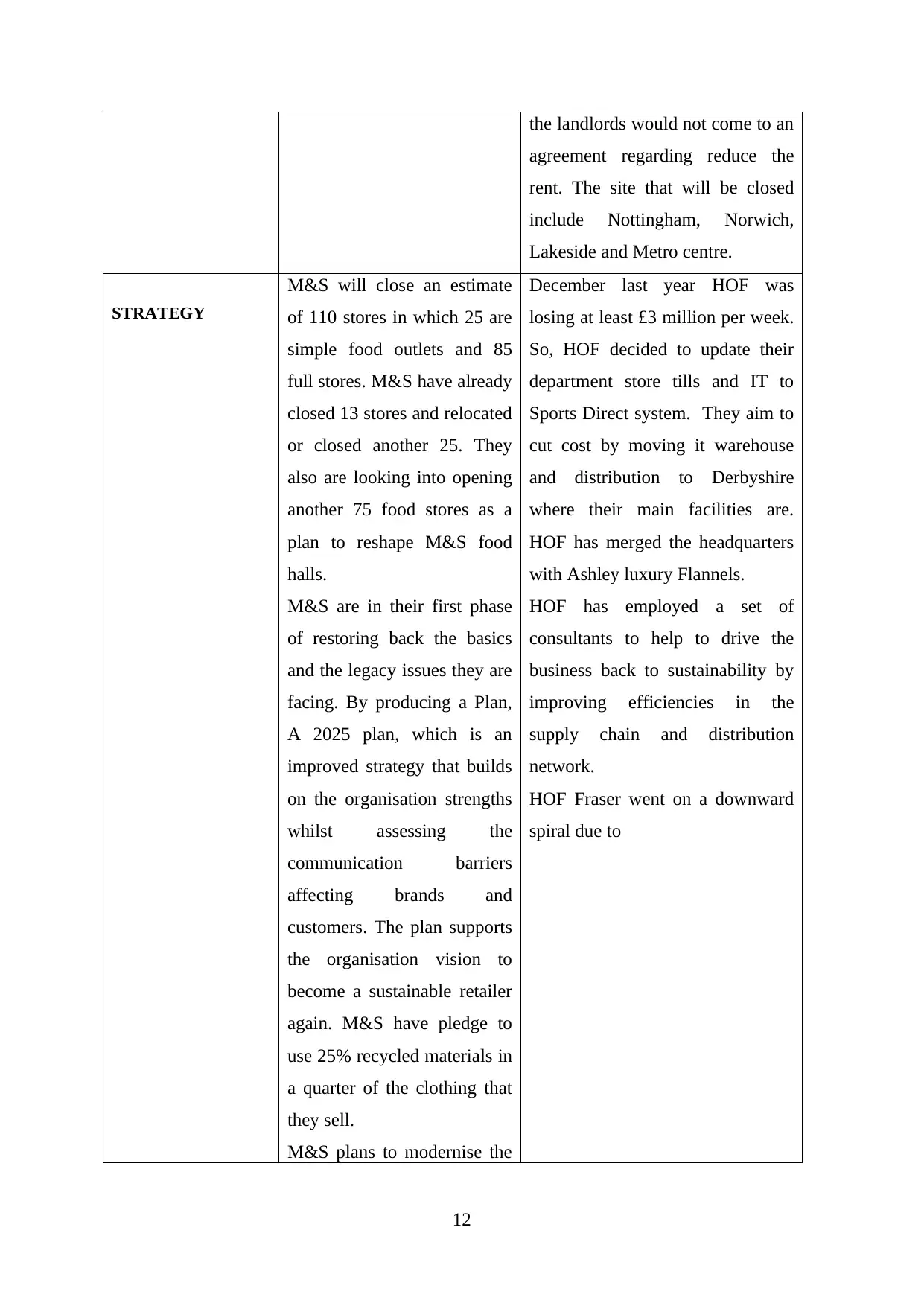
the landlords would not come to an
agreement regarding reduce the
rent. The site that will be closed
include Nottingham, Norwich,
Lakeside and Metro centre.
STRATEGY
M&S will close an estimate
of 110 stores in which 25 are
simple food outlets and 85
full stores. M&S have already
closed 13 stores and relocated
or closed another 25. They
also are looking into opening
another 75 food stores as a
plan to reshape M&S food
halls.
M&S are in their first phase
of restoring back the basics
and the legacy issues they are
facing. By producing a Plan,
A 2025 plan, which is an
improved strategy that builds
on the organisation strengths
whilst assessing the
communication barriers
affecting brands and
customers. The plan supports
the organisation vision to
become a sustainable retailer
again. M&S have pledge to
use 25% recycled materials in
a quarter of the clothing that
they sell.
M&S plans to modernise the
December last year HOF was
losing at least £3 million per week.
So, HOF decided to update their
department store tills and IT to
Sports Direct system. They aim to
cut cost by moving it warehouse
and distribution to Derbyshire
where their main facilities are.
HOF has merged the headquarters
with Ashley luxury Flannels.
HOF has employed a set of
consultants to help to drive the
business back to sustainability by
improving efficiencies in the
supply chain and distribution
network.
HOF Fraser went on a downward
spiral due to
12
agreement regarding reduce the
rent. The site that will be closed
include Nottingham, Norwich,
Lakeside and Metro centre.
STRATEGY
M&S will close an estimate
of 110 stores in which 25 are
simple food outlets and 85
full stores. M&S have already
closed 13 stores and relocated
or closed another 25. They
also are looking into opening
another 75 food stores as a
plan to reshape M&S food
halls.
M&S are in their first phase
of restoring back the basics
and the legacy issues they are
facing. By producing a Plan,
A 2025 plan, which is an
improved strategy that builds
on the organisation strengths
whilst assessing the
communication barriers
affecting brands and
customers. The plan supports
the organisation vision to
become a sustainable retailer
again. M&S have pledge to
use 25% recycled materials in
a quarter of the clothing that
they sell.
M&S plans to modernise the
December last year HOF was
losing at least £3 million per week.
So, HOF decided to update their
department store tills and IT to
Sports Direct system. They aim to
cut cost by moving it warehouse
and distribution to Derbyshire
where their main facilities are.
HOF has merged the headquarters
with Ashley luxury Flannels.
HOF has employed a set of
consultants to help to drive the
business back to sustainability by
improving efficiencies in the
supply chain and distribution
network.
HOF Fraser went on a downward
spiral due to
12
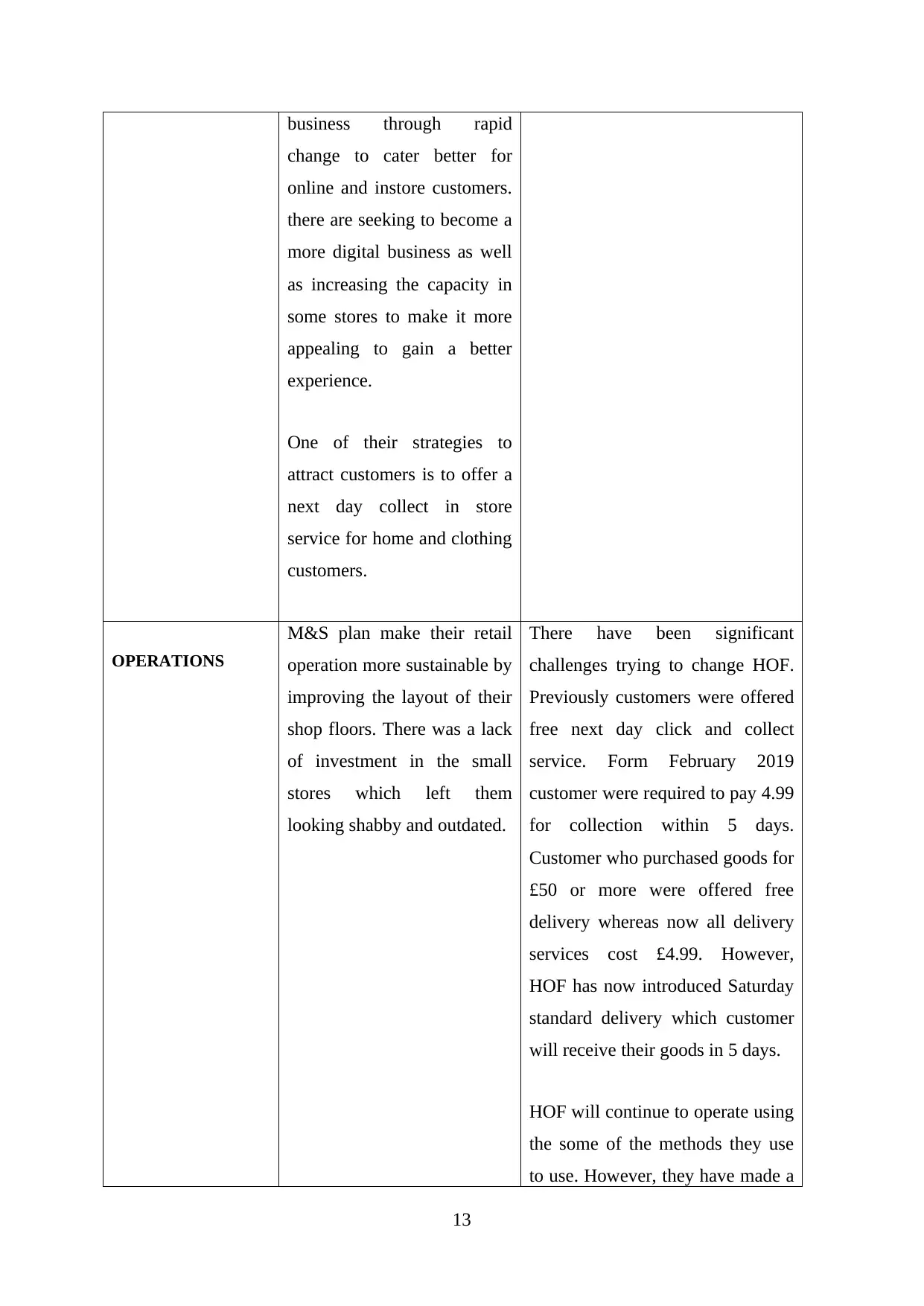
business through rapid
change to cater better for
online and instore customers.
there are seeking to become a
more digital business as well
as increasing the capacity in
some stores to make it more
appealing to gain a better
experience.
One of their strategies to
attract customers is to offer a
next day collect in store
service for home and clothing
customers.
OPERATIONS
M&S plan make their retail
operation more sustainable by
improving the layout of their
shop floors. There was a lack
of investment in the small
stores which left them
looking shabby and outdated.
There have been significant
challenges trying to change HOF.
Previously customers were offered
free next day click and collect
service. Form February 2019
customer were required to pay 4.99
for collection within 5 days.
Customer who purchased goods for
£50 or more were offered free
delivery whereas now all delivery
services cost £4.99. However,
HOF has now introduced Saturday
standard delivery which customer
will receive their goods in 5 days.
HOF will continue to operate using
the some of the methods they use
to use. However, they have made a
13
change to cater better for
online and instore customers.
there are seeking to become a
more digital business as well
as increasing the capacity in
some stores to make it more
appealing to gain a better
experience.
One of their strategies to
attract customers is to offer a
next day collect in store
service for home and clothing
customers.
OPERATIONS
M&S plan make their retail
operation more sustainable by
improving the layout of their
shop floors. There was a lack
of investment in the small
stores which left them
looking shabby and outdated.
There have been significant
challenges trying to change HOF.
Previously customers were offered
free next day click and collect
service. Form February 2019
customer were required to pay 4.99
for collection within 5 days.
Customer who purchased goods for
£50 or more were offered free
delivery whereas now all delivery
services cost £4.99. However,
HOF has now introduced Saturday
standard delivery which customer
will receive their goods in 5 days.
HOF will continue to operate using
the some of the methods they use
to use. However, they have made a
13
Paraphrase This Document
Need a fresh take? Get an instant paraphrase of this document with our AI Paraphraser
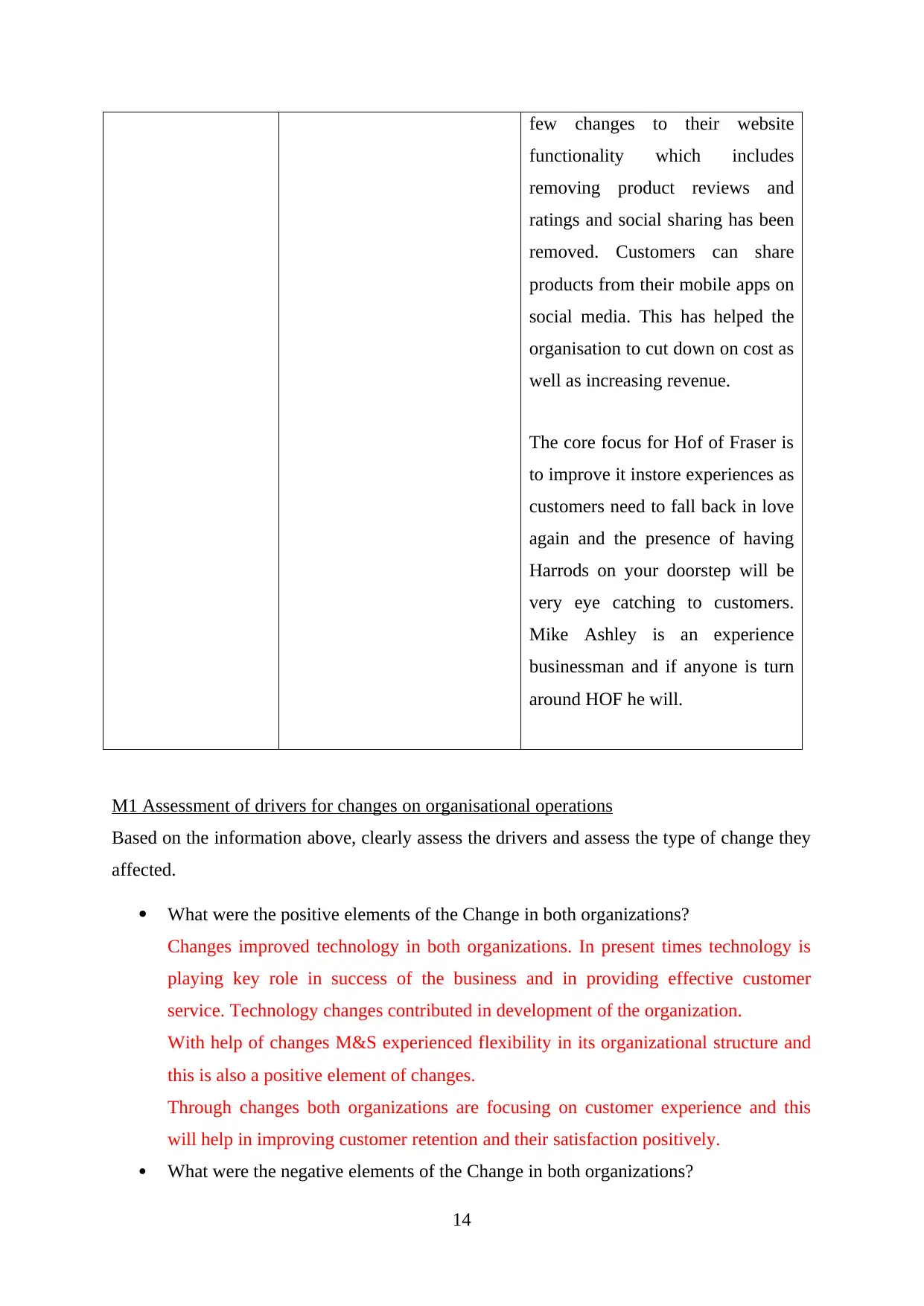
few changes to their website
functionality which includes
removing product reviews and
ratings and social sharing has been
removed. Customers can share
products from their mobile apps on
social media. This has helped the
organisation to cut down on cost as
well as increasing revenue.
The core focus for Hof of Fraser is
to improve it instore experiences as
customers need to fall back in love
again and the presence of having
Harrods on your doorstep will be
very eye catching to customers.
Mike Ashley is an experience
businessman and if anyone is turn
around HOF he will.
M1 Assessment of drivers for changes on organisational operations
Based on the information above, clearly assess the drivers and assess the type of change they
affected.
What were the positive elements of the Change in both organizations?
Changes improved technology in both organizations. In present times technology is
playing key role in success of the business and in providing effective customer
service. Technology changes contributed in development of the organization.
With help of changes M&S experienced flexibility in its organizational structure and
this is also a positive element of changes.
Through changes both organizations are focusing on customer experience and this
will help in improving customer retention and their satisfaction positively.
What were the negative elements of the Change in both organizations?
14
functionality which includes
removing product reviews and
ratings and social sharing has been
removed. Customers can share
products from their mobile apps on
social media. This has helped the
organisation to cut down on cost as
well as increasing revenue.
The core focus for Hof of Fraser is
to improve it instore experiences as
customers need to fall back in love
again and the presence of having
Harrods on your doorstep will be
very eye catching to customers.
Mike Ashley is an experience
businessman and if anyone is turn
around HOF he will.
M1 Assessment of drivers for changes on organisational operations
Based on the information above, clearly assess the drivers and assess the type of change they
affected.
What were the positive elements of the Change in both organizations?
Changes improved technology in both organizations. In present times technology is
playing key role in success of the business and in providing effective customer
service. Technology changes contributed in development of the organization.
With help of changes M&S experienced flexibility in its organizational structure and
this is also a positive element of changes.
Through changes both organizations are focusing on customer experience and this
will help in improving customer retention and their satisfaction positively.
What were the negative elements of the Change in both organizations?
14
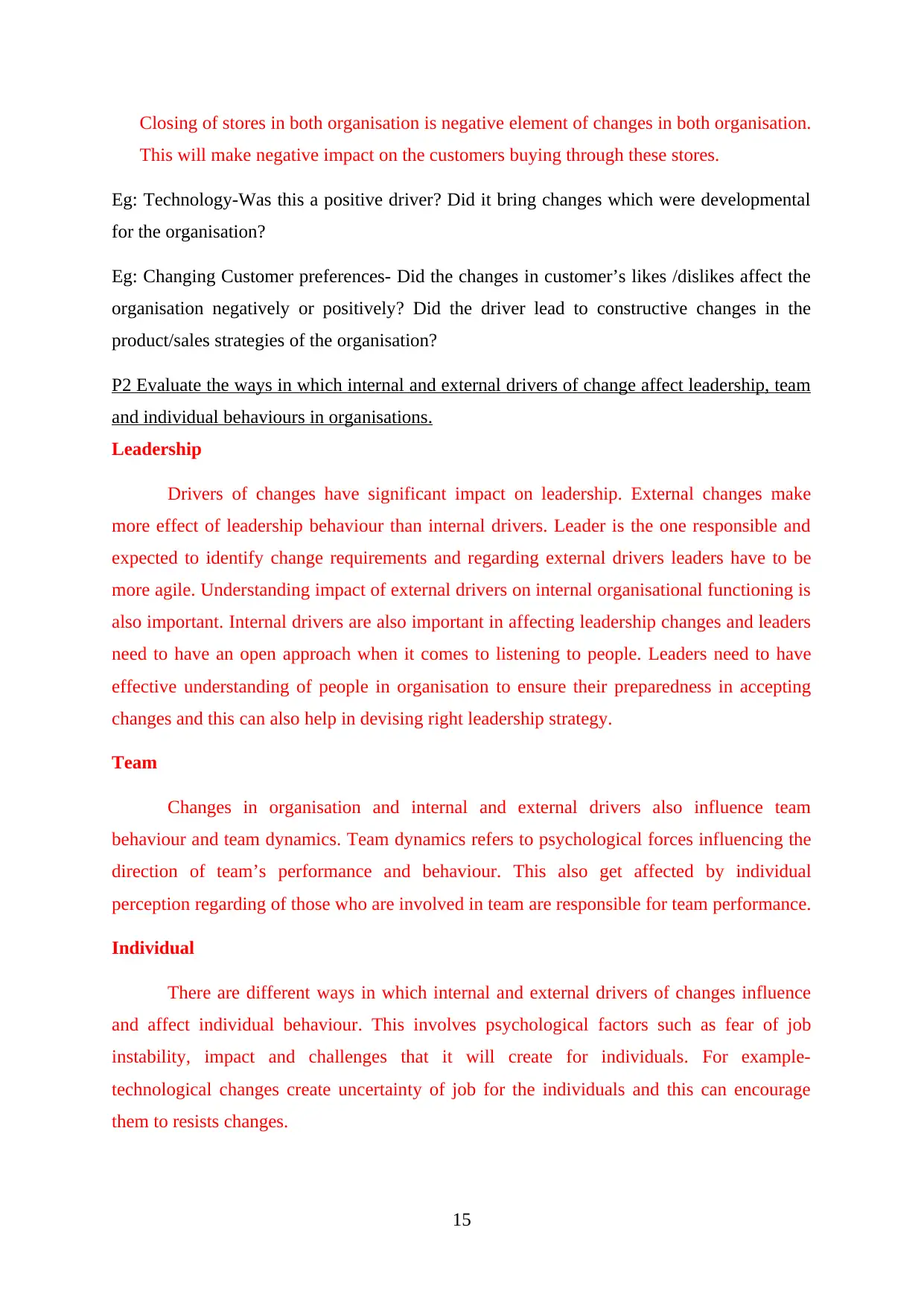
Closing of stores in both organisation is negative element of changes in both organisation.
This will make negative impact on the customers buying through these stores.
Eg: Technology-Was this a positive driver? Did it bring changes which were developmental
for the organisation?
Eg: Changing Customer preferences- Did the changes in customer’s likes /dislikes affect the
organisation negatively or positively? Did the driver lead to constructive changes in the
product/sales strategies of the organisation?
P2 Evaluate the ways in which internal and external drivers of change affect leadership, team
and individual behaviours in organisations.
Leadership
Drivers of changes have significant impact on leadership. External changes make
more effect of leadership behaviour than internal drivers. Leader is the one responsible and
expected to identify change requirements and regarding external drivers leaders have to be
more agile. Understanding impact of external drivers on internal organisational functioning is
also important. Internal drivers are also important in affecting leadership changes and leaders
need to have an open approach when it comes to listening to people. Leaders need to have
effective understanding of people in organisation to ensure their preparedness in accepting
changes and this can also help in devising right leadership strategy.
Team
Changes in organisation and internal and external drivers also influence team
behaviour and team dynamics. Team dynamics refers to psychological forces influencing the
direction of team’s performance and behaviour. This also get affected by individual
perception regarding of those who are involved in team are responsible for team performance.
Individual
There are different ways in which internal and external drivers of changes influence
and affect individual behaviour. This involves psychological factors such as fear of job
instability, impact and challenges that it will create for individuals. For example-
technological changes create uncertainty of job for the individuals and this can encourage
them to resists changes.
15
This will make negative impact on the customers buying through these stores.
Eg: Technology-Was this a positive driver? Did it bring changes which were developmental
for the organisation?
Eg: Changing Customer preferences- Did the changes in customer’s likes /dislikes affect the
organisation negatively or positively? Did the driver lead to constructive changes in the
product/sales strategies of the organisation?
P2 Evaluate the ways in which internal and external drivers of change affect leadership, team
and individual behaviours in organisations.
Leadership
Drivers of changes have significant impact on leadership. External changes make
more effect of leadership behaviour than internal drivers. Leader is the one responsible and
expected to identify change requirements and regarding external drivers leaders have to be
more agile. Understanding impact of external drivers on internal organisational functioning is
also important. Internal drivers are also important in affecting leadership changes and leaders
need to have an open approach when it comes to listening to people. Leaders need to have
effective understanding of people in organisation to ensure their preparedness in accepting
changes and this can also help in devising right leadership strategy.
Team
Changes in organisation and internal and external drivers also influence team
behaviour and team dynamics. Team dynamics refers to psychological forces influencing the
direction of team’s performance and behaviour. This also get affected by individual
perception regarding of those who are involved in team are responsible for team performance.
Individual
There are different ways in which internal and external drivers of changes influence
and affect individual behaviour. This involves psychological factors such as fear of job
instability, impact and challenges that it will create for individuals. For example-
technological changes create uncertainty of job for the individuals and this can encourage
them to resists changes.
15
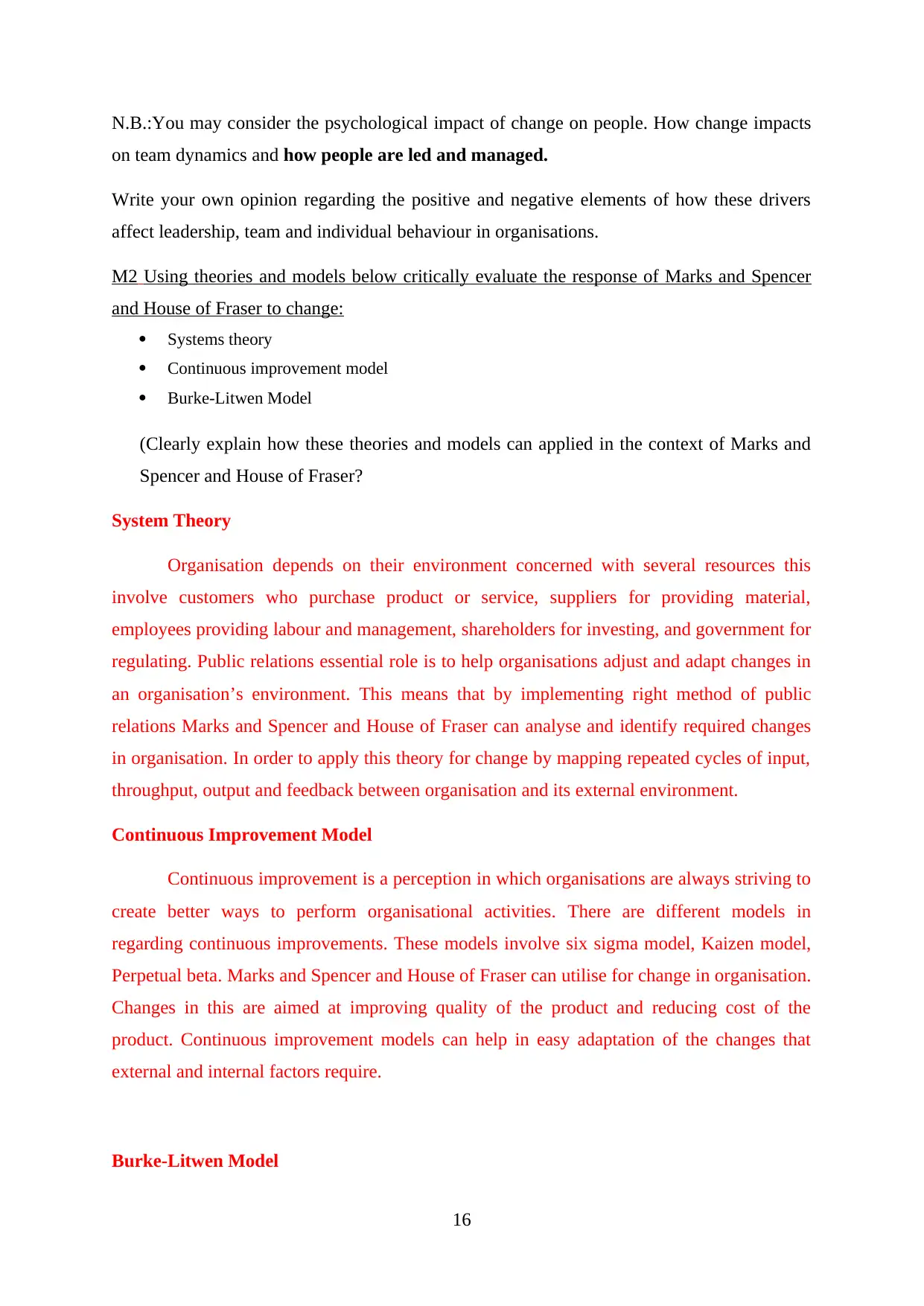
N.B.:You may consider the psychological impact of change on people. How change impacts
on team dynamics and how people are led and managed.
Write your own opinion regarding the positive and negative elements of how these drivers
affect leadership, team and individual behaviour in organisations.
M2 Using theories and models below critically evaluate the response of Marks and Spencer
and House of Fraser to change:
Systems theory
Continuous improvement model
Burke-Litwen Model
(Clearly explain how these theories and models can applied in the context of Marks and
Spencer and House of Fraser?
System Theory
Organisation depends on their environment concerned with several resources this
involve customers who purchase product or service, suppliers for providing material,
employees providing labour and management, shareholders for investing, and government for
regulating. Public relations essential role is to help organisations adjust and adapt changes in
an organisation’s environment. This means that by implementing right method of public
relations Marks and Spencer and House of Fraser can analyse and identify required changes
in organisation. In order to apply this theory for change by mapping repeated cycles of input,
throughput, output and feedback between organisation and its external environment.
Continuous Improvement Model
Continuous improvement is a perception in which organisations are always striving to
create better ways to perform organisational activities. There are different models in
regarding continuous improvements. These models involve six sigma model, Kaizen model,
Perpetual beta. Marks and Spencer and House of Fraser can utilise for change in organisation.
Changes in this are aimed at improving quality of the product and reducing cost of the
product. Continuous improvement models can help in easy adaptation of the changes that
external and internal factors require.
Burke-Litwen Model
16
on team dynamics and how people are led and managed.
Write your own opinion regarding the positive and negative elements of how these drivers
affect leadership, team and individual behaviour in organisations.
M2 Using theories and models below critically evaluate the response of Marks and Spencer
and House of Fraser to change:
Systems theory
Continuous improvement model
Burke-Litwen Model
(Clearly explain how these theories and models can applied in the context of Marks and
Spencer and House of Fraser?
System Theory
Organisation depends on their environment concerned with several resources this
involve customers who purchase product or service, suppliers for providing material,
employees providing labour and management, shareholders for investing, and government for
regulating. Public relations essential role is to help organisations adjust and adapt changes in
an organisation’s environment. This means that by implementing right method of public
relations Marks and Spencer and House of Fraser can analyse and identify required changes
in organisation. In order to apply this theory for change by mapping repeated cycles of input,
throughput, output and feedback between organisation and its external environment.
Continuous Improvement Model
Continuous improvement is a perception in which organisations are always striving to
create better ways to perform organisational activities. There are different models in
regarding continuous improvements. These models involve six sigma model, Kaizen model,
Perpetual beta. Marks and Spencer and House of Fraser can utilise for change in organisation.
Changes in this are aimed at improving quality of the product and reducing cost of the
product. Continuous improvement models can help in easy adaptation of the changes that
external and internal factors require.
Burke-Litwen Model
16
Secure Best Marks with AI Grader
Need help grading? Try our AI Grader for instant feedback on your assignments.
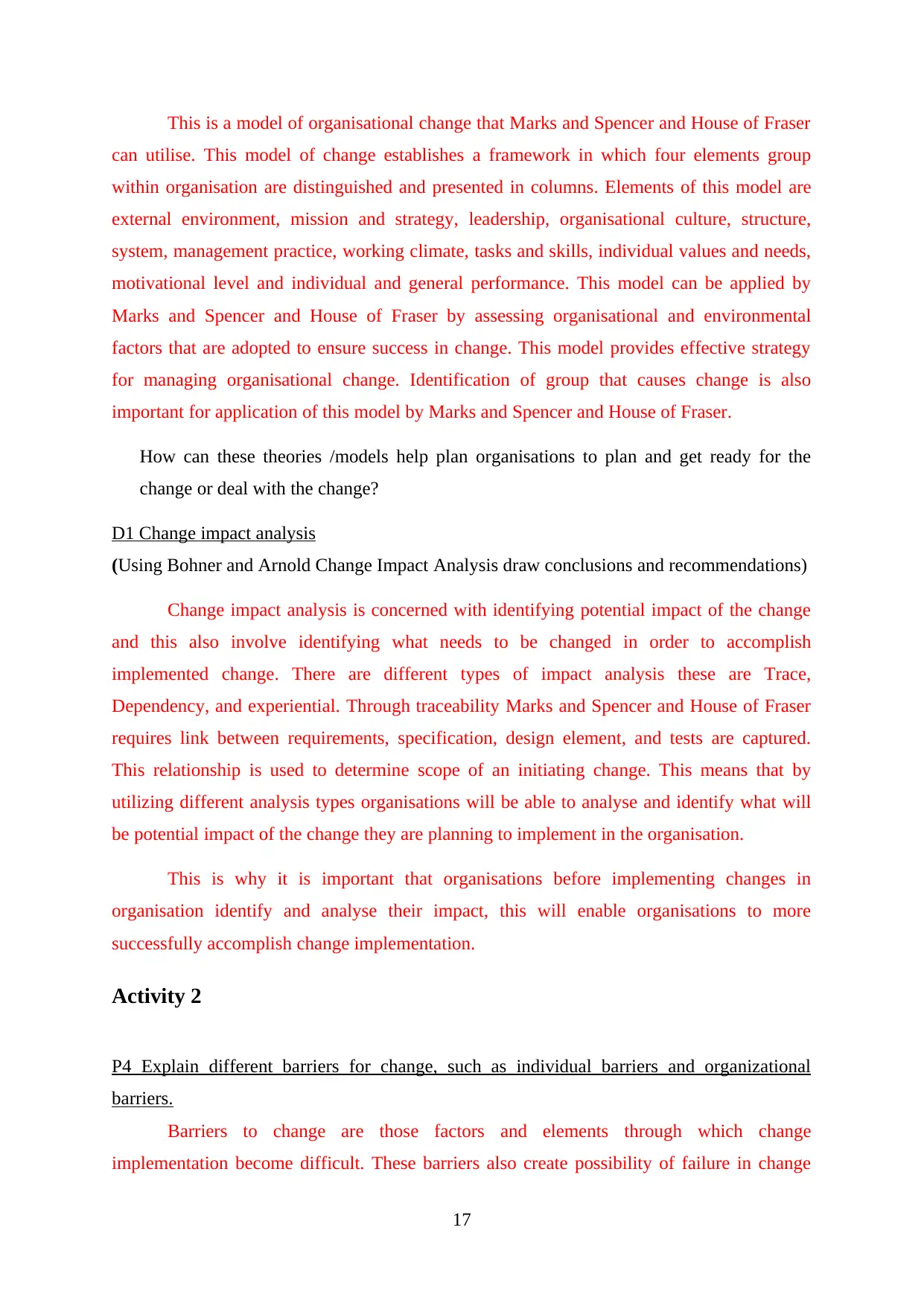
This is a model of organisational change that Marks and Spencer and House of Fraser
can utilise. This model of change establishes a framework in which four elements group
within organisation are distinguished and presented in columns. Elements of this model are
external environment, mission and strategy, leadership, organisational culture, structure,
system, management practice, working climate, tasks and skills, individual values and needs,
motivational level and individual and general performance. This model can be applied by
Marks and Spencer and House of Fraser by assessing organisational and environmental
factors that are adopted to ensure success in change. This model provides effective strategy
for managing organisational change. Identification of group that causes change is also
important for application of this model by Marks and Spencer and House of Fraser.
How can these theories /models help plan organisations to plan and get ready for the
change or deal with the change?
D1 Change impact analysis
(Using Bohner and Arnold Change Impact Analysis draw conclusions and recommendations)
Change impact analysis is concerned with identifying potential impact of the change
and this also involve identifying what needs to be changed in order to accomplish
implemented change. There are different types of impact analysis these are Trace,
Dependency, and experiential. Through traceability Marks and Spencer and House of Fraser
requires link between requirements, specification, design element, and tests are captured.
This relationship is used to determine scope of an initiating change. This means that by
utilizing different analysis types organisations will be able to analyse and identify what will
be potential impact of the change they are planning to implement in the organisation.
This is why it is important that organisations before implementing changes in
organisation identify and analyse their impact, this will enable organisations to more
successfully accomplish change implementation.
Activity 2
P4 Explain different barriers for change, such as individual barriers and organizational
barriers.
Barriers to change are those factors and elements through which change
implementation become difficult. These barriers also create possibility of failure in change
17
can utilise. This model of change establishes a framework in which four elements group
within organisation are distinguished and presented in columns. Elements of this model are
external environment, mission and strategy, leadership, organisational culture, structure,
system, management practice, working climate, tasks and skills, individual values and needs,
motivational level and individual and general performance. This model can be applied by
Marks and Spencer and House of Fraser by assessing organisational and environmental
factors that are adopted to ensure success in change. This model provides effective strategy
for managing organisational change. Identification of group that causes change is also
important for application of this model by Marks and Spencer and House of Fraser.
How can these theories /models help plan organisations to plan and get ready for the
change or deal with the change?
D1 Change impact analysis
(Using Bohner and Arnold Change Impact Analysis draw conclusions and recommendations)
Change impact analysis is concerned with identifying potential impact of the change
and this also involve identifying what needs to be changed in order to accomplish
implemented change. There are different types of impact analysis these are Trace,
Dependency, and experiential. Through traceability Marks and Spencer and House of Fraser
requires link between requirements, specification, design element, and tests are captured.
This relationship is used to determine scope of an initiating change. This means that by
utilizing different analysis types organisations will be able to analyse and identify what will
be potential impact of the change they are planning to implement in the organisation.
This is why it is important that organisations before implementing changes in
organisation identify and analyse their impact, this will enable organisations to more
successfully accomplish change implementation.
Activity 2
P4 Explain different barriers for change, such as individual barriers and organizational
barriers.
Barriers to change are those factors and elements through which change
implementation become difficult. These barriers also create possibility of failure in change
17
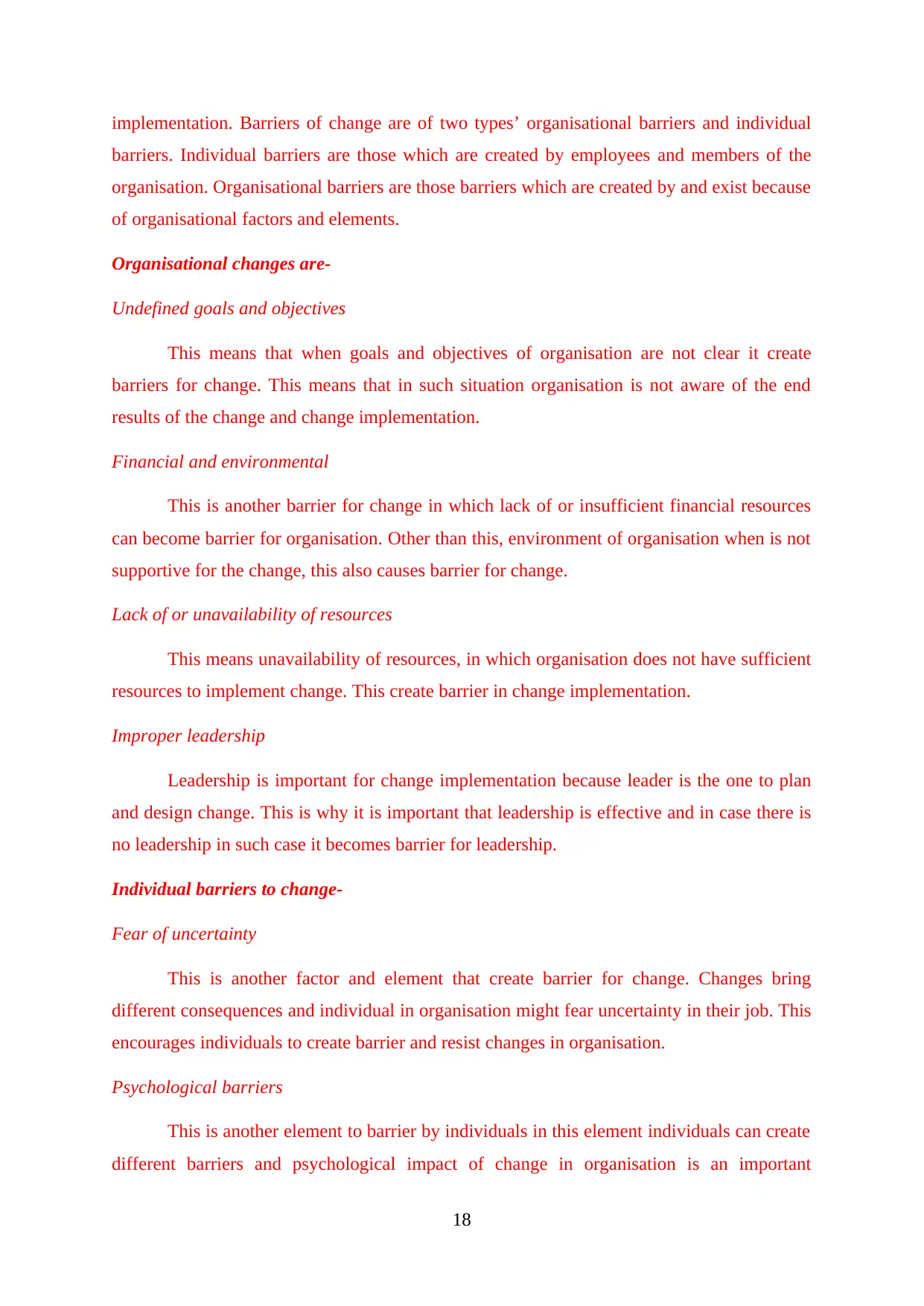
implementation. Barriers of change are of two types’ organisational barriers and individual
barriers. Individual barriers are those which are created by employees and members of the
organisation. Organisational barriers are those barriers which are created by and exist because
of organisational factors and elements.
Organisational changes are-
Undefined goals and objectives
This means that when goals and objectives of organisation are not clear it create
barriers for change. This means that in such situation organisation is not aware of the end
results of the change and change implementation.
Financial and environmental
This is another barrier for change in which lack of or insufficient financial resources
can become barrier for organisation. Other than this, environment of organisation when is not
supportive for the change, this also causes barrier for change.
Lack of or unavailability of resources
This means unavailability of resources, in which organisation does not have sufficient
resources to implement change. This create barrier in change implementation.
Improper leadership
Leadership is important for change implementation because leader is the one to plan
and design change. This is why it is important that leadership is effective and in case there is
no leadership in such case it becomes barrier for leadership.
Individual barriers to change-
Fear of uncertainty
This is another factor and element that create barrier for change. Changes bring
different consequences and individual in organisation might fear uncertainty in their job. This
encourages individuals to create barrier and resist changes in organisation.
Psychological barriers
This is another element to barrier by individuals in this element individuals can create
different barriers and psychological impact of change in organisation is an important
18
barriers. Individual barriers are those which are created by employees and members of the
organisation. Organisational barriers are those barriers which are created by and exist because
of organisational factors and elements.
Organisational changes are-
Undefined goals and objectives
This means that when goals and objectives of organisation are not clear it create
barriers for change. This means that in such situation organisation is not aware of the end
results of the change and change implementation.
Financial and environmental
This is another barrier for change in which lack of or insufficient financial resources
can become barrier for organisation. Other than this, environment of organisation when is not
supportive for the change, this also causes barrier for change.
Lack of or unavailability of resources
This means unavailability of resources, in which organisation does not have sufficient
resources to implement change. This create barrier in change implementation.
Improper leadership
Leadership is important for change implementation because leader is the one to plan
and design change. This is why it is important that leadership is effective and in case there is
no leadership in such case it becomes barrier for leadership.
Individual barriers to change-
Fear of uncertainty
This is another factor and element that create barrier for change. Changes bring
different consequences and individual in organisation might fear uncertainty in their job. This
encourages individuals to create barrier and resist changes in organisation.
Psychological barriers
This is another element to barrier by individuals in this element individuals can create
different barriers and psychological impact of change in organisation is an important
18
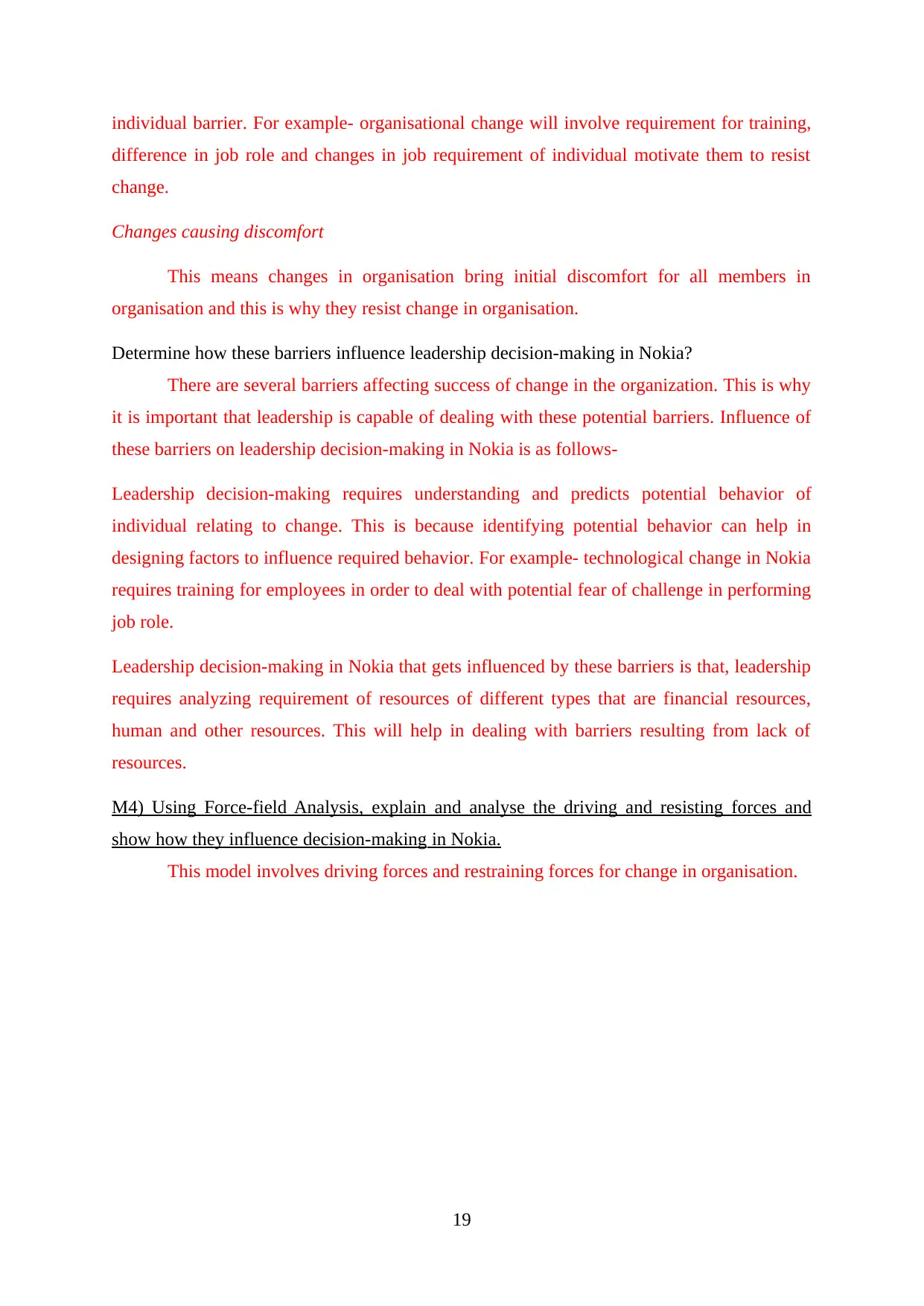
individual barrier. For example- organisational change will involve requirement for training,
difference in job role and changes in job requirement of individual motivate them to resist
change.
Changes causing discomfort
This means changes in organisation bring initial discomfort for all members in
organisation and this is why they resist change in organisation.
Determine how these barriers influence leadership decision-making in Nokia?
There are several barriers affecting success of change in the organization. This is why
it is important that leadership is capable of dealing with these potential barriers. Influence of
these barriers on leadership decision-making in Nokia is as follows-
Leadership decision-making requires understanding and predicts potential behavior of
individual relating to change. This is because identifying potential behavior can help in
designing factors to influence required behavior. For example- technological change in Nokia
requires training for employees in order to deal with potential fear of challenge in performing
job role.
Leadership decision-making in Nokia that gets influenced by these barriers is that, leadership
requires analyzing requirement of resources of different types that are financial resources,
human and other resources. This will help in dealing with barriers resulting from lack of
resources.
M4) Using Force-field Analysis, explain and analyse the driving and resisting forces and
show how they influence decision-making in Nokia.
This model involves driving forces and restraining forces for change in organisation.
19
difference in job role and changes in job requirement of individual motivate them to resist
change.
Changes causing discomfort
This means changes in organisation bring initial discomfort for all members in
organisation and this is why they resist change in organisation.
Determine how these barriers influence leadership decision-making in Nokia?
There are several barriers affecting success of change in the organization. This is why
it is important that leadership is capable of dealing with these potential barriers. Influence of
these barriers on leadership decision-making in Nokia is as follows-
Leadership decision-making requires understanding and predicts potential behavior of
individual relating to change. This is because identifying potential behavior can help in
designing factors to influence required behavior. For example- technological change in Nokia
requires training for employees in order to deal with potential fear of challenge in performing
job role.
Leadership decision-making in Nokia that gets influenced by these barriers is that, leadership
requires analyzing requirement of resources of different types that are financial resources,
human and other resources. This will help in dealing with barriers resulting from lack of
resources.
M4) Using Force-field Analysis, explain and analyse the driving and resisting forces and
show how they influence decision-making in Nokia.
This model involves driving forces and restraining forces for change in organisation.
19
Paraphrase This Document
Need a fresh take? Get an instant paraphrase of this document with our AI Paraphraser
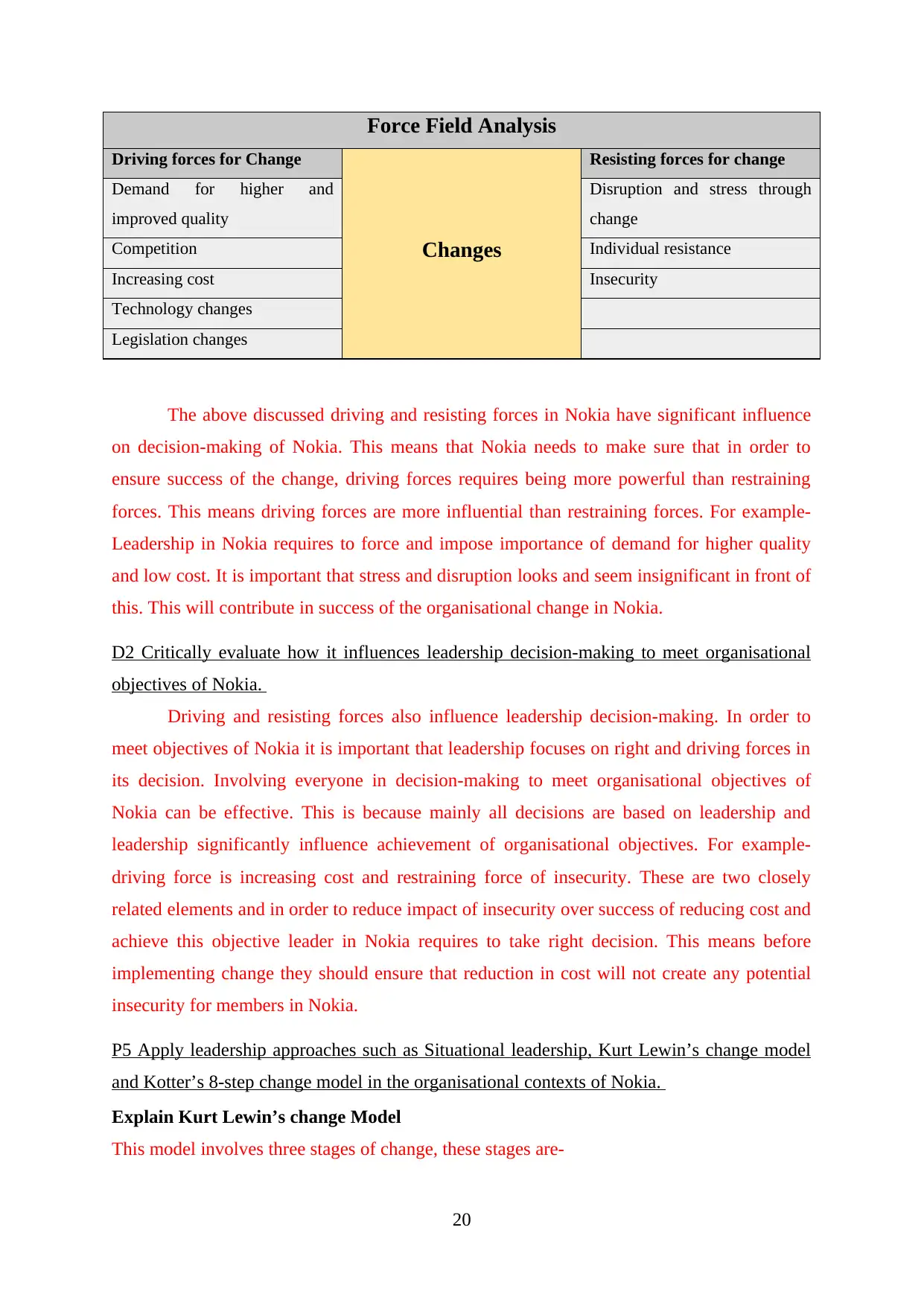
Force Field Analysis
Driving forces for Change
Changes
Resisting forces for change
Demand for higher and
improved quality
Disruption and stress through
change
Competition Individual resistance
Increasing cost Insecurity
Technology changes
Legislation changes
The above discussed driving and resisting forces in Nokia have significant influence
on decision-making of Nokia. This means that Nokia needs to make sure that in order to
ensure success of the change, driving forces requires being more powerful than restraining
forces. This means driving forces are more influential than restraining forces. For example-
Leadership in Nokia requires to force and impose importance of demand for higher quality
and low cost. It is important that stress and disruption looks and seem insignificant in front of
this. This will contribute in success of the organisational change in Nokia.
D2 Critically evaluate how it influences leadership decision-making to meet organisational
objectives of Nokia.
Driving and resisting forces also influence leadership decision-making. In order to
meet objectives of Nokia it is important that leadership focuses on right and driving forces in
its decision. Involving everyone in decision-making to meet organisational objectives of
Nokia can be effective. This is because mainly all decisions are based on leadership and
leadership significantly influence achievement of organisational objectives. For example-
driving force is increasing cost and restraining force of insecurity. These are two closely
related elements and in order to reduce impact of insecurity over success of reducing cost and
achieve this objective leader in Nokia requires to take right decision. This means before
implementing change they should ensure that reduction in cost will not create any potential
insecurity for members in Nokia.
P5 Apply leadership approaches such as Situational leadership, Kurt Lewin’s change model
and Kotter’s 8-step change model in the organisational contexts of Nokia.
Explain Kurt Lewin’s change Model
This model involves three stages of change, these stages are-
20
Driving forces for Change
Changes
Resisting forces for change
Demand for higher and
improved quality
Disruption and stress through
change
Competition Individual resistance
Increasing cost Insecurity
Technology changes
Legislation changes
The above discussed driving and resisting forces in Nokia have significant influence
on decision-making of Nokia. This means that Nokia needs to make sure that in order to
ensure success of the change, driving forces requires being more powerful than restraining
forces. This means driving forces are more influential than restraining forces. For example-
Leadership in Nokia requires to force and impose importance of demand for higher quality
and low cost. It is important that stress and disruption looks and seem insignificant in front of
this. This will contribute in success of the organisational change in Nokia.
D2 Critically evaluate how it influences leadership decision-making to meet organisational
objectives of Nokia.
Driving and resisting forces also influence leadership decision-making. In order to
meet objectives of Nokia it is important that leadership focuses on right and driving forces in
its decision. Involving everyone in decision-making to meet organisational objectives of
Nokia can be effective. This is because mainly all decisions are based on leadership and
leadership significantly influence achievement of organisational objectives. For example-
driving force is increasing cost and restraining force of insecurity. These are two closely
related elements and in order to reduce impact of insecurity over success of reducing cost and
achieve this objective leader in Nokia requires to take right decision. This means before
implementing change they should ensure that reduction in cost will not create any potential
insecurity for members in Nokia.
P5 Apply leadership approaches such as Situational leadership, Kurt Lewin’s change model
and Kotter’s 8-step change model in the organisational contexts of Nokia.
Explain Kurt Lewin’s change Model
This model involves three stages of change, these stages are-
20
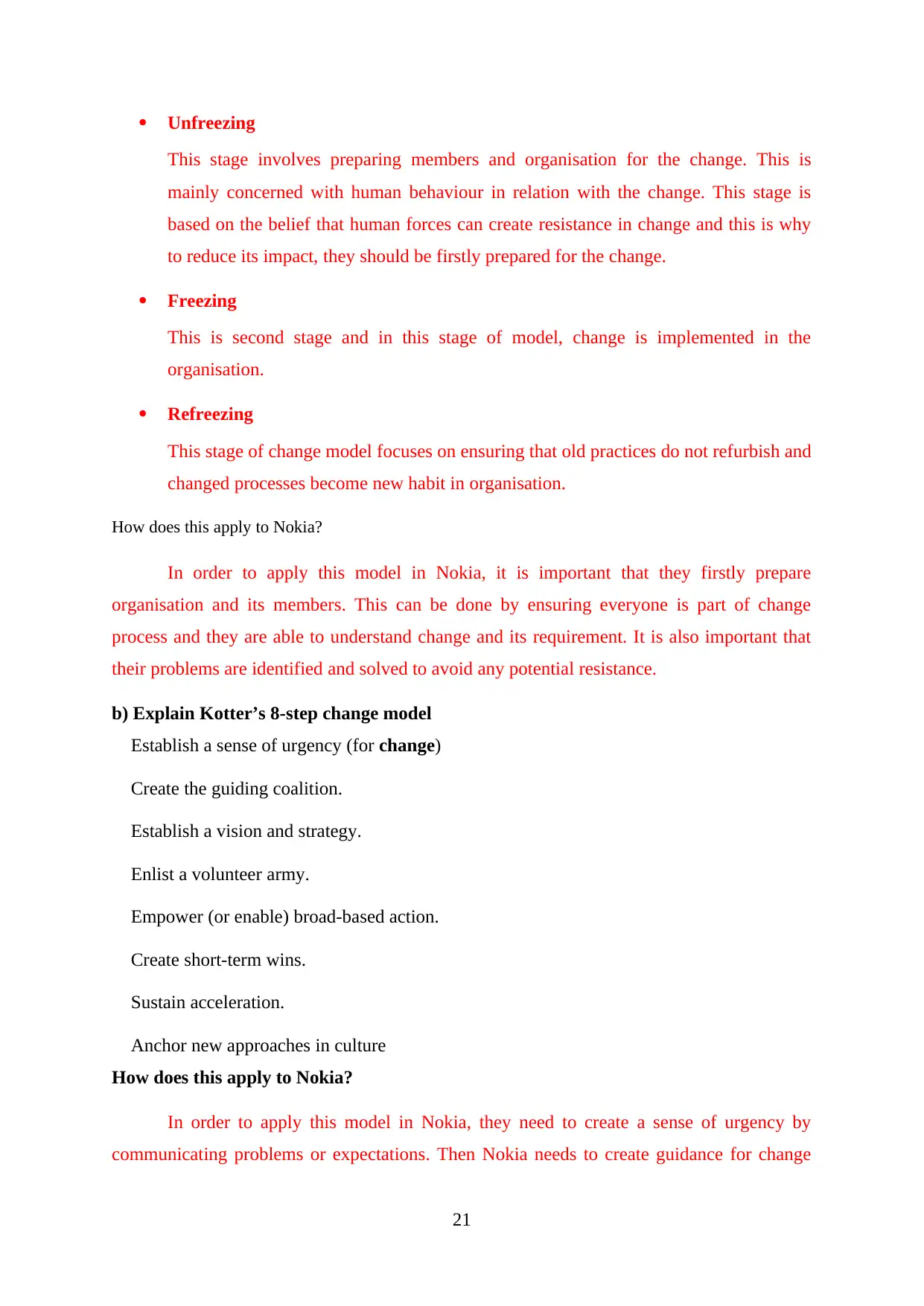
Unfreezing
This stage involves preparing members and organisation for the change. This is
mainly concerned with human behaviour in relation with the change. This stage is
based on the belief that human forces can create resistance in change and this is why
to reduce its impact, they should be firstly prepared for the change.
Freezing
This is second stage and in this stage of model, change is implemented in the
organisation.
Refreezing
This stage of change model focuses on ensuring that old practices do not refurbish and
changed processes become new habit in organisation.
How does this apply to Nokia?
In order to apply this model in Nokia, it is important that they firstly prepare
organisation and its members. This can be done by ensuring everyone is part of change
process and they are able to understand change and its requirement. It is also important that
their problems are identified and solved to avoid any potential resistance.
b) Explain Kotter’s 8-step change model
Establish a sense of urgency (for change)
Create the guiding coalition.
Establish a vision and strategy.
Enlist a volunteer army.
Empower (or enable) broad-based action.
Create short-term wins.
Sustain acceleration.
Anchor new approaches in culture
How does this apply to Nokia?
In order to apply this model in Nokia, they need to create a sense of urgency by
communicating problems or expectations. Then Nokia needs to create guidance for change
21
This stage involves preparing members and organisation for the change. This is
mainly concerned with human behaviour in relation with the change. This stage is
based on the belief that human forces can create resistance in change and this is why
to reduce its impact, they should be firstly prepared for the change.
Freezing
This is second stage and in this stage of model, change is implemented in the
organisation.
Refreezing
This stage of change model focuses on ensuring that old practices do not refurbish and
changed processes become new habit in organisation.
How does this apply to Nokia?
In order to apply this model in Nokia, it is important that they firstly prepare
organisation and its members. This can be done by ensuring everyone is part of change
process and they are able to understand change and its requirement. It is also important that
their problems are identified and solved to avoid any potential resistance.
b) Explain Kotter’s 8-step change model
Establish a sense of urgency (for change)
Create the guiding coalition.
Establish a vision and strategy.
Enlist a volunteer army.
Empower (or enable) broad-based action.
Create short-term wins.
Sustain acceleration.
Anchor new approaches in culture
How does this apply to Nokia?
In order to apply this model in Nokia, they need to create a sense of urgency by
communicating problems or expectations. Then Nokia needs to create guidance for change
21
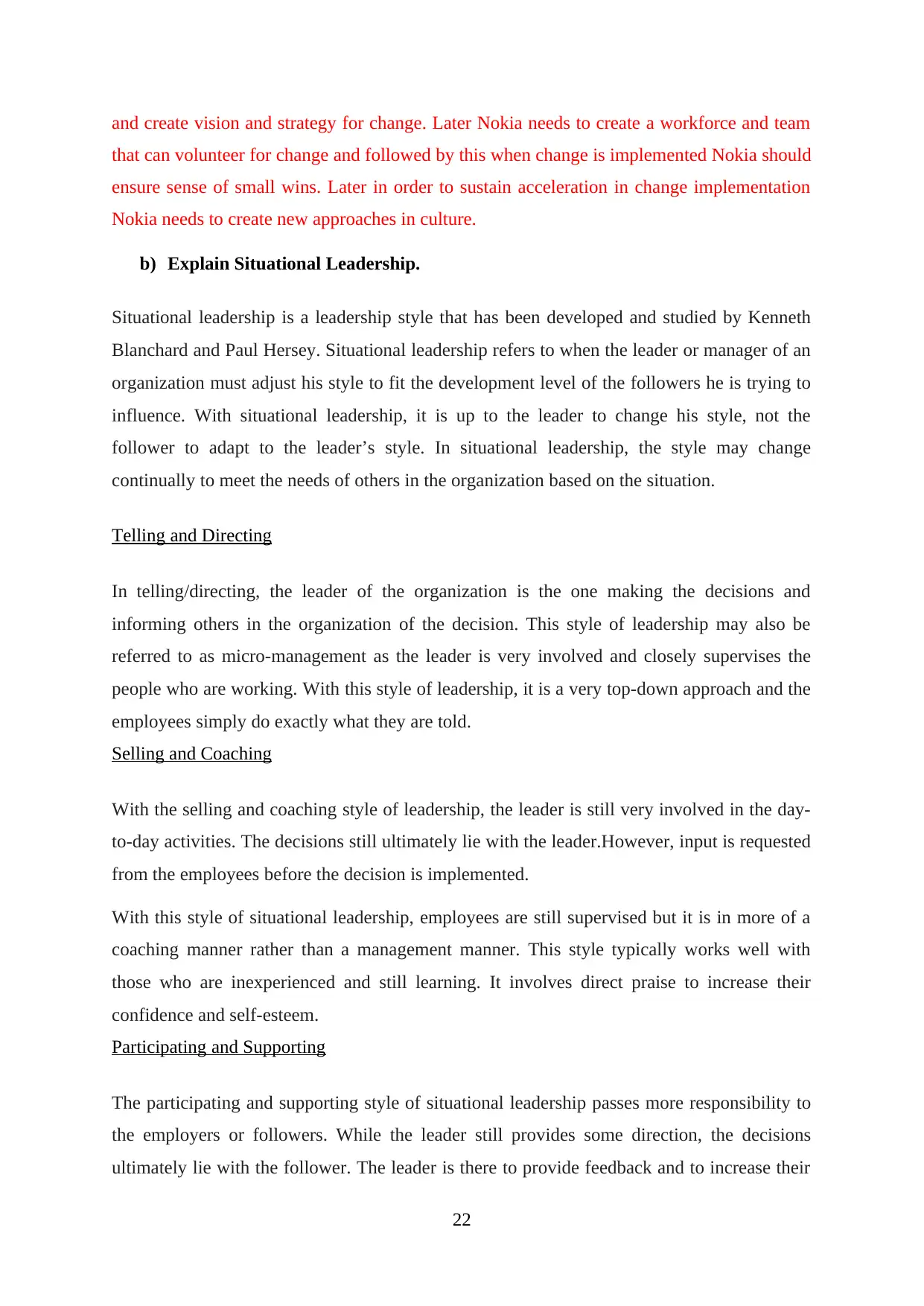
and create vision and strategy for change. Later Nokia needs to create a workforce and team
that can volunteer for change and followed by this when change is implemented Nokia should
ensure sense of small wins. Later in order to sustain acceleration in change implementation
Nokia needs to create new approaches in culture.
b) Explain Situational Leadership.
Situational leadership is a leadership style that has been developed and studied by Kenneth
Blanchard and Paul Hersey. Situational leadership refers to when the leader or manager of an
organization must adjust his style to fit the development level of the followers he is trying to
influence. With situational leadership, it is up to the leader to change his style, not the
follower to adapt to the leader’s style. In situational leadership, the style may change
continually to meet the needs of others in the organization based on the situation.
Telling and Directing
In telling/directing, the leader of the organization is the one making the decisions and
informing others in the organization of the decision. This style of leadership may also be
referred to as micro-management as the leader is very involved and closely supervises the
people who are working. With this style of leadership, it is a very top-down approach and the
employees simply do exactly what they are told.
Selling and Coaching
With the selling and coaching style of leadership, the leader is still very involved in the day-
to-day activities. The decisions still ultimately lie with the leader.However, input is requested
from the employees before the decision is implemented.
With this style of situational leadership, employees are still supervised but it is in more of a
coaching manner rather than a management manner. This style typically works well with
those who are inexperienced and still learning. It involves direct praise to increase their
confidence and self-esteem.
Participating and Supporting
The participating and supporting style of situational leadership passes more responsibility to
the employers or followers. While the leader still provides some direction, the decisions
ultimately lie with the follower. The leader is there to provide feedback and to increase their
22
that can volunteer for change and followed by this when change is implemented Nokia should
ensure sense of small wins. Later in order to sustain acceleration in change implementation
Nokia needs to create new approaches in culture.
b) Explain Situational Leadership.
Situational leadership is a leadership style that has been developed and studied by Kenneth
Blanchard and Paul Hersey. Situational leadership refers to when the leader or manager of an
organization must adjust his style to fit the development level of the followers he is trying to
influence. With situational leadership, it is up to the leader to change his style, not the
follower to adapt to the leader’s style. In situational leadership, the style may change
continually to meet the needs of others in the organization based on the situation.
Telling and Directing
In telling/directing, the leader of the organization is the one making the decisions and
informing others in the organization of the decision. This style of leadership may also be
referred to as micro-management as the leader is very involved and closely supervises the
people who are working. With this style of leadership, it is a very top-down approach and the
employees simply do exactly what they are told.
Selling and Coaching
With the selling and coaching style of leadership, the leader is still very involved in the day-
to-day activities. The decisions still ultimately lie with the leader.However, input is requested
from the employees before the decision is implemented.
With this style of situational leadership, employees are still supervised but it is in more of a
coaching manner rather than a management manner. This style typically works well with
those who are inexperienced and still learning. It involves direct praise to increase their
confidence and self-esteem.
Participating and Supporting
The participating and supporting style of situational leadership passes more responsibility to
the employers or followers. While the leader still provides some direction, the decisions
ultimately lie with the follower. The leader is there to provide feedback and to increase their
22
Secure Best Marks with AI Grader
Need help grading? Try our AI Grader for instant feedback on your assignments.
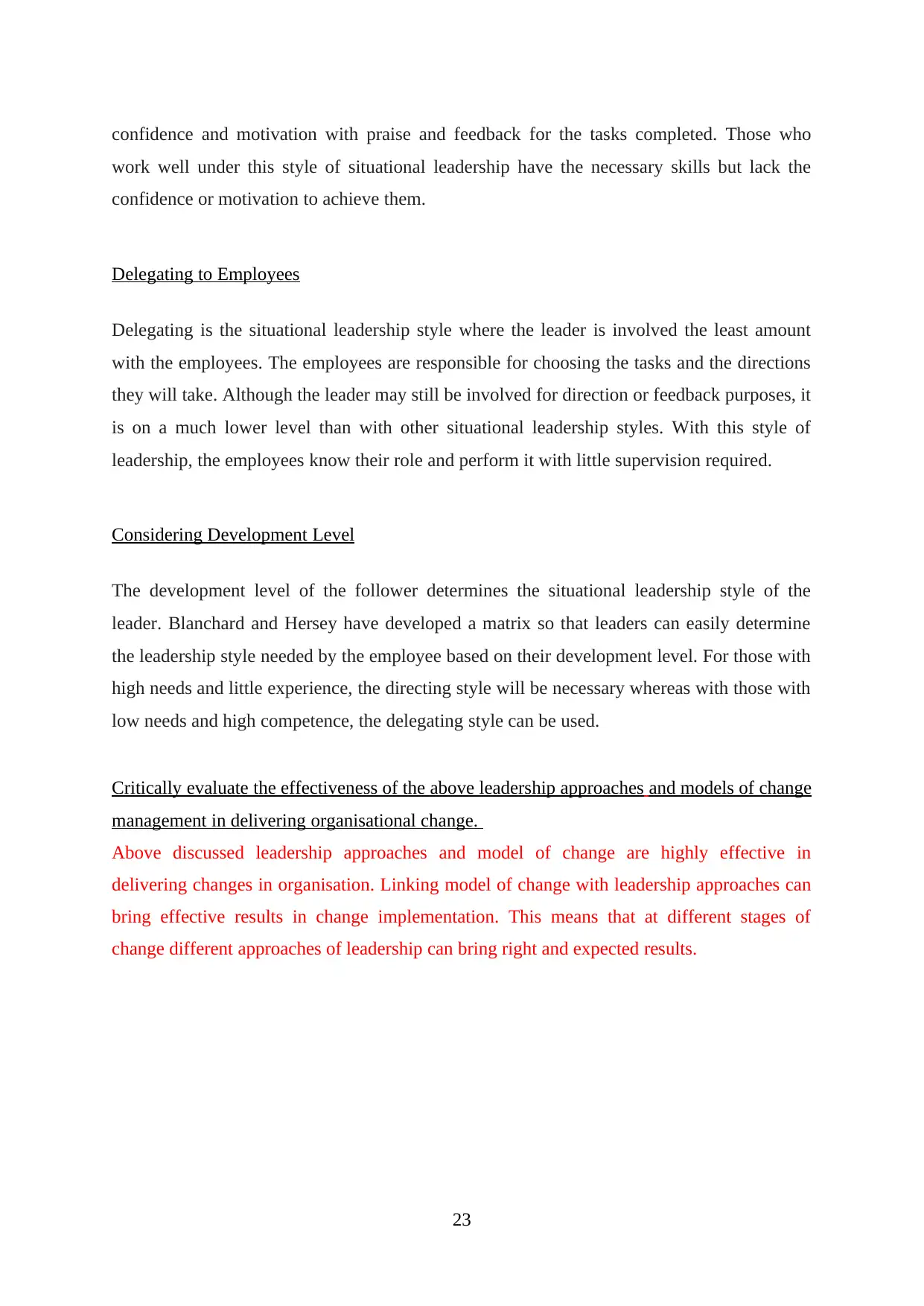
confidence and motivation with praise and feedback for the tasks completed. Those who
work well under this style of situational leadership have the necessary skills but lack the
confidence or motivation to achieve them.
Delegating to Employees
Delegating is the situational leadership style where the leader is involved the least amount
with the employees. The employees are responsible for choosing the tasks and the directions
they will take. Although the leader may still be involved for direction or feedback purposes, it
is on a much lower level than with other situational leadership styles. With this style of
leadership, the employees know their role and perform it with little supervision required.
Considering Development Level
The development level of the follower determines the situational leadership style of the
leader. Blanchard and Hersey have developed a matrix so that leaders can easily determine
the leadership style needed by the employee based on their development level. For those with
high needs and little experience, the directing style will be necessary whereas with those with
low needs and high competence, the delegating style can be used.
Critically evaluate the effectiveness of the above leadership approaches and models of change
management in delivering organisational change.
Above discussed leadership approaches and model of change are highly effective in
delivering changes in organisation. Linking model of change with leadership approaches can
bring effective results in change implementation. This means that at different stages of
change different approaches of leadership can bring right and expected results.
23
work well under this style of situational leadership have the necessary skills but lack the
confidence or motivation to achieve them.
Delegating to Employees
Delegating is the situational leadership style where the leader is involved the least amount
with the employees. The employees are responsible for choosing the tasks and the directions
they will take. Although the leader may still be involved for direction or feedback purposes, it
is on a much lower level than with other situational leadership styles. With this style of
leadership, the employees know their role and perform it with little supervision required.
Considering Development Level
The development level of the follower determines the situational leadership style of the
leader. Blanchard and Hersey have developed a matrix so that leaders can easily determine
the leadership style needed by the employee based on their development level. For those with
high needs and little experience, the directing style will be necessary whereas with those with
low needs and high competence, the delegating style can be used.
Critically evaluate the effectiveness of the above leadership approaches and models of change
management in delivering organisational change.
Above discussed leadership approaches and model of change are highly effective in
delivering changes in organisation. Linking model of change with leadership approaches can
bring effective results in change implementation. This means that at different stages of
change different approaches of leadership can bring right and expected results.
23
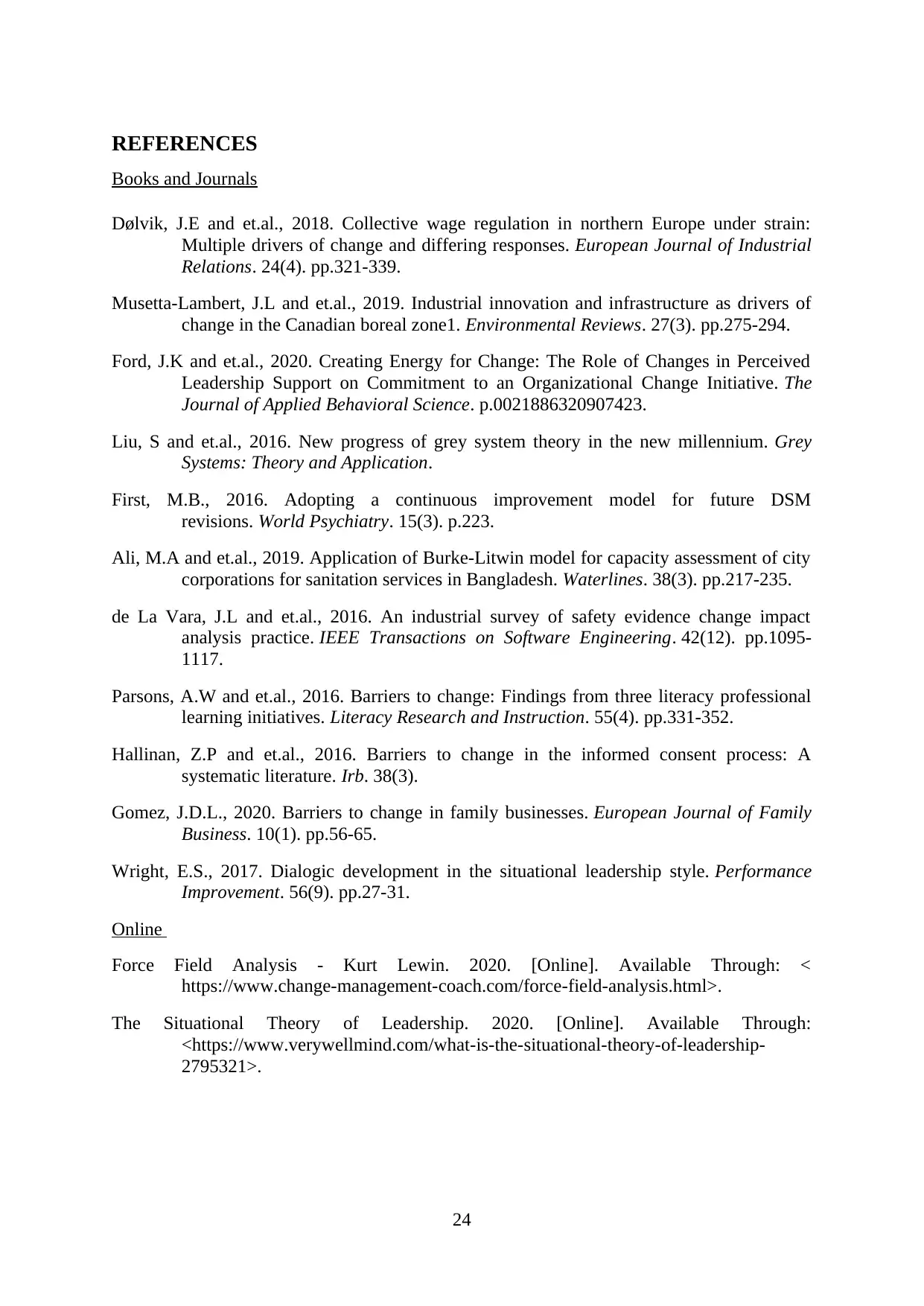
REFERENCES
Books and Journals
Dølvik, J.E and et.al., 2018. Collective wage regulation in northern Europe under strain:
Multiple drivers of change and differing responses. European Journal of Industrial
Relations. 24(4). pp.321-339.
Musetta-Lambert, J.L and et.al., 2019. Industrial innovation and infrastructure as drivers of
change in the Canadian boreal zone1. Environmental Reviews. 27(3). pp.275-294.
Ford, J.K and et.al., 2020. Creating Energy for Change: The Role of Changes in Perceived
Leadership Support on Commitment to an Organizational Change Initiative. The
Journal of Applied Behavioral Science. p.0021886320907423.
Liu, S and et.al., 2016. New progress of grey system theory in the new millennium. Grey
Systems: Theory and Application.
First, M.B., 2016. Adopting a continuous improvement model for future DSM
revisions. World Psychiatry. 15(3). p.223.
Ali, M.A and et.al., 2019. Application of Burke-Litwin model for capacity assessment of city
corporations for sanitation services in Bangladesh. Waterlines. 38(3). pp.217-235.
de La Vara, J.L and et.al., 2016. An industrial survey of safety evidence change impact
analysis practice. IEEE Transactions on Software Engineering. 42(12). pp.1095-
1117.
Parsons, A.W and et.al., 2016. Barriers to change: Findings from three literacy professional
learning initiatives. Literacy Research and Instruction. 55(4). pp.331-352.
Hallinan, Z.P and et.al., 2016. Barriers to change in the informed consent process: A
systematic literature. Irb. 38(3).
Gomez, J.D.L., 2020. Barriers to change in family businesses. European Journal of Family
Business. 10(1). pp.56-65.
Wright, E.S., 2017. Dialogic development in the situational leadership style. Performance
Improvement. 56(9). pp.27-31.
Online
Force Field Analysis - Kurt Lewin. 2020. [Online]. Available Through: <
https://www.change-management-coach.com/force-field-analysis.html>.
The Situational Theory of Leadership. 2020. [Online]. Available Through:
<https://www.verywellmind.com/what-is-the-situational-theory-of-leadership-
2795321>.
24
Books and Journals
Dølvik, J.E and et.al., 2018. Collective wage regulation in northern Europe under strain:
Multiple drivers of change and differing responses. European Journal of Industrial
Relations. 24(4). pp.321-339.
Musetta-Lambert, J.L and et.al., 2019. Industrial innovation and infrastructure as drivers of
change in the Canadian boreal zone1. Environmental Reviews. 27(3). pp.275-294.
Ford, J.K and et.al., 2020. Creating Energy for Change: The Role of Changes in Perceived
Leadership Support on Commitment to an Organizational Change Initiative. The
Journal of Applied Behavioral Science. p.0021886320907423.
Liu, S and et.al., 2016. New progress of grey system theory in the new millennium. Grey
Systems: Theory and Application.
First, M.B., 2016. Adopting a continuous improvement model for future DSM
revisions. World Psychiatry. 15(3). p.223.
Ali, M.A and et.al., 2019. Application of Burke-Litwin model for capacity assessment of city
corporations for sanitation services in Bangladesh. Waterlines. 38(3). pp.217-235.
de La Vara, J.L and et.al., 2016. An industrial survey of safety evidence change impact
analysis practice. IEEE Transactions on Software Engineering. 42(12). pp.1095-
1117.
Parsons, A.W and et.al., 2016. Barriers to change: Findings from three literacy professional
learning initiatives. Literacy Research and Instruction. 55(4). pp.331-352.
Hallinan, Z.P and et.al., 2016. Barriers to change in the informed consent process: A
systematic literature. Irb. 38(3).
Gomez, J.D.L., 2020. Barriers to change in family businesses. European Journal of Family
Business. 10(1). pp.56-65.
Wright, E.S., 2017. Dialogic development in the situational leadership style. Performance
Improvement. 56(9). pp.27-31.
Online
Force Field Analysis - Kurt Lewin. 2020. [Online]. Available Through: <
https://www.change-management-coach.com/force-field-analysis.html>.
The Situational Theory of Leadership. 2020. [Online]. Available Through:
<https://www.verywellmind.com/what-is-the-situational-theory-of-leadership-
2795321>.
24
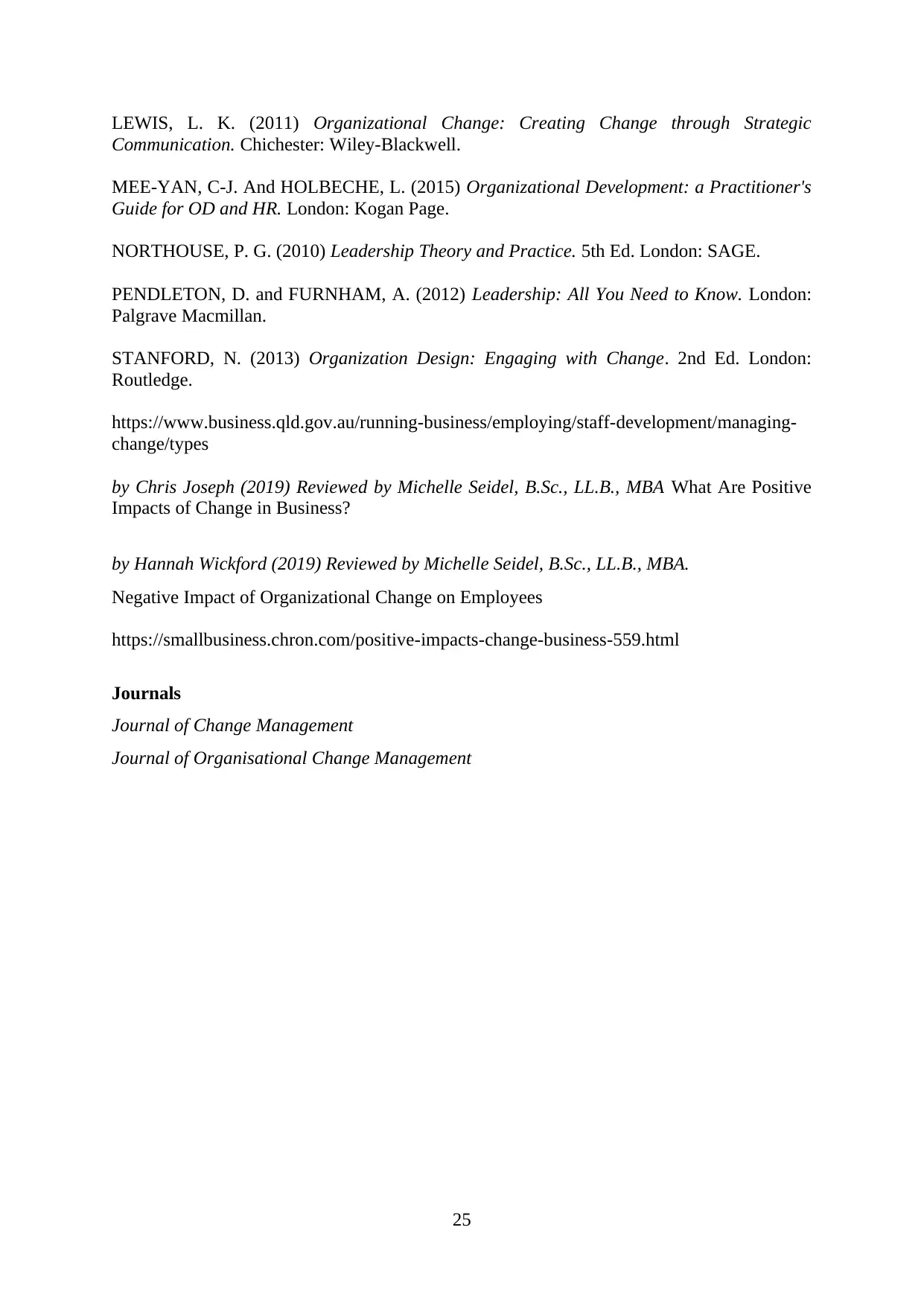
LEWIS, L. K. (2011) Organizational Change: Creating Change through Strategic
Communication. Chichester: Wiley-Blackwell.
MEE-YAN, C-J. And HOLBECHE, L. (2015) Organizational Development: a Practitioner's
Guide for OD and HR. London: Kogan Page.
NORTHOUSE, P. G. (2010) Leadership Theory and Practice. 5th Ed. London: SAGE.
PENDLETON, D. and FURNHAM, A. (2012) Leadership: All You Need to Know. London:
Palgrave Macmillan.
STANFORD, N. (2013) Organization Design: Engaging with Change. 2nd Ed. London:
Routledge.
https://www.business.qld.gov.au/running-business/employing/staff-development/managing-
change/types
by Chris Joseph (2019) Reviewed by Michelle Seidel, B.Sc., LL.B., MBA What Are Positive
Impacts of Change in Business?
by Hannah Wickford (2019) Reviewed by Michelle Seidel, B.Sc., LL.B., MBA.
Negative Impact of Organizational Change on Employees
https://smallbusiness.chron.com/positive-impacts-change-business-559.html
Journals
Journal of Change Management
Journal of Organisational Change Management
25
Communication. Chichester: Wiley-Blackwell.
MEE-YAN, C-J. And HOLBECHE, L. (2015) Organizational Development: a Practitioner's
Guide for OD and HR. London: Kogan Page.
NORTHOUSE, P. G. (2010) Leadership Theory and Practice. 5th Ed. London: SAGE.
PENDLETON, D. and FURNHAM, A. (2012) Leadership: All You Need to Know. London:
Palgrave Macmillan.
STANFORD, N. (2013) Organization Design: Engaging with Change. 2nd Ed. London:
Routledge.
https://www.business.qld.gov.au/running-business/employing/staff-development/managing-
change/types
by Chris Joseph (2019) Reviewed by Michelle Seidel, B.Sc., LL.B., MBA What Are Positive
Impacts of Change in Business?
by Hannah Wickford (2019) Reviewed by Michelle Seidel, B.Sc., LL.B., MBA.
Negative Impact of Organizational Change on Employees
https://smallbusiness.chron.com/positive-impacts-change-business-559.html
Journals
Journal of Change Management
Journal of Organisational Change Management
25
1 out of 25
Related Documents
Your All-in-One AI-Powered Toolkit for Academic Success.
+13062052269
info@desklib.com
Available 24*7 on WhatsApp / Email
![[object Object]](/_next/static/media/star-bottom.7253800d.svg)
Unlock your academic potential
© 2024 | Zucol Services PVT LTD | All rights reserved.




